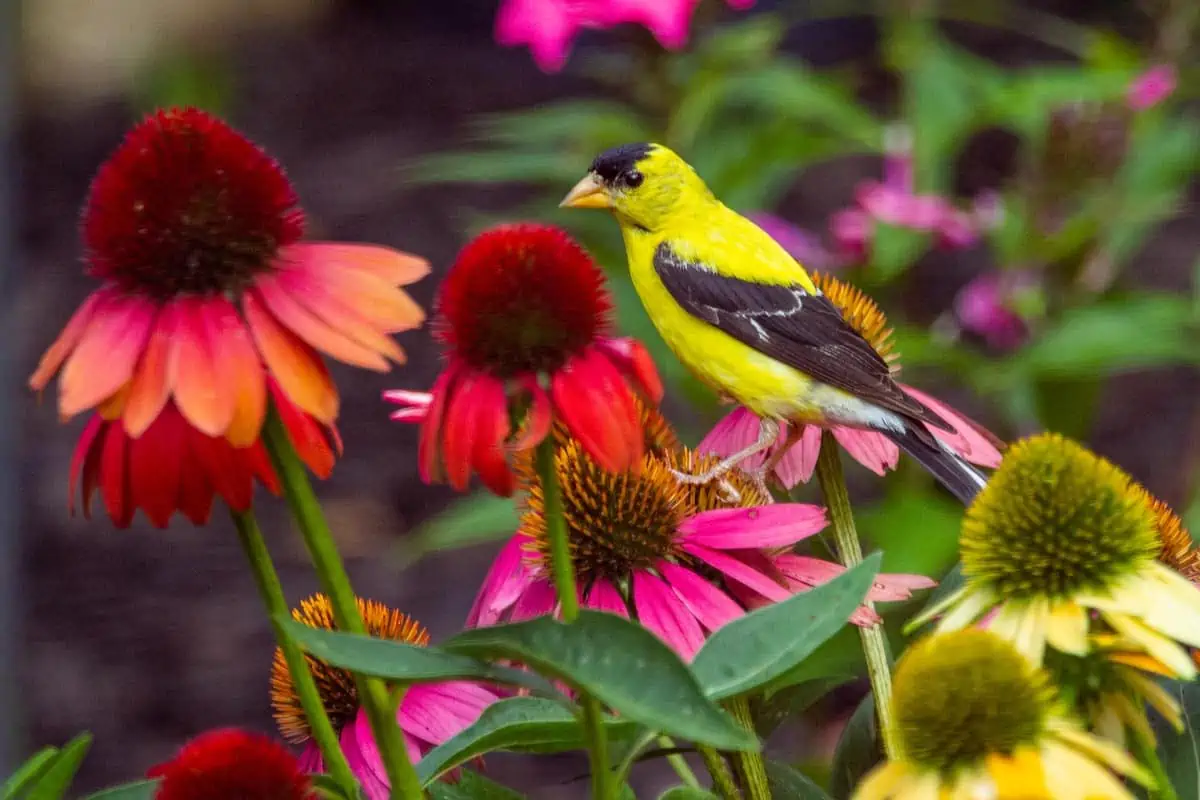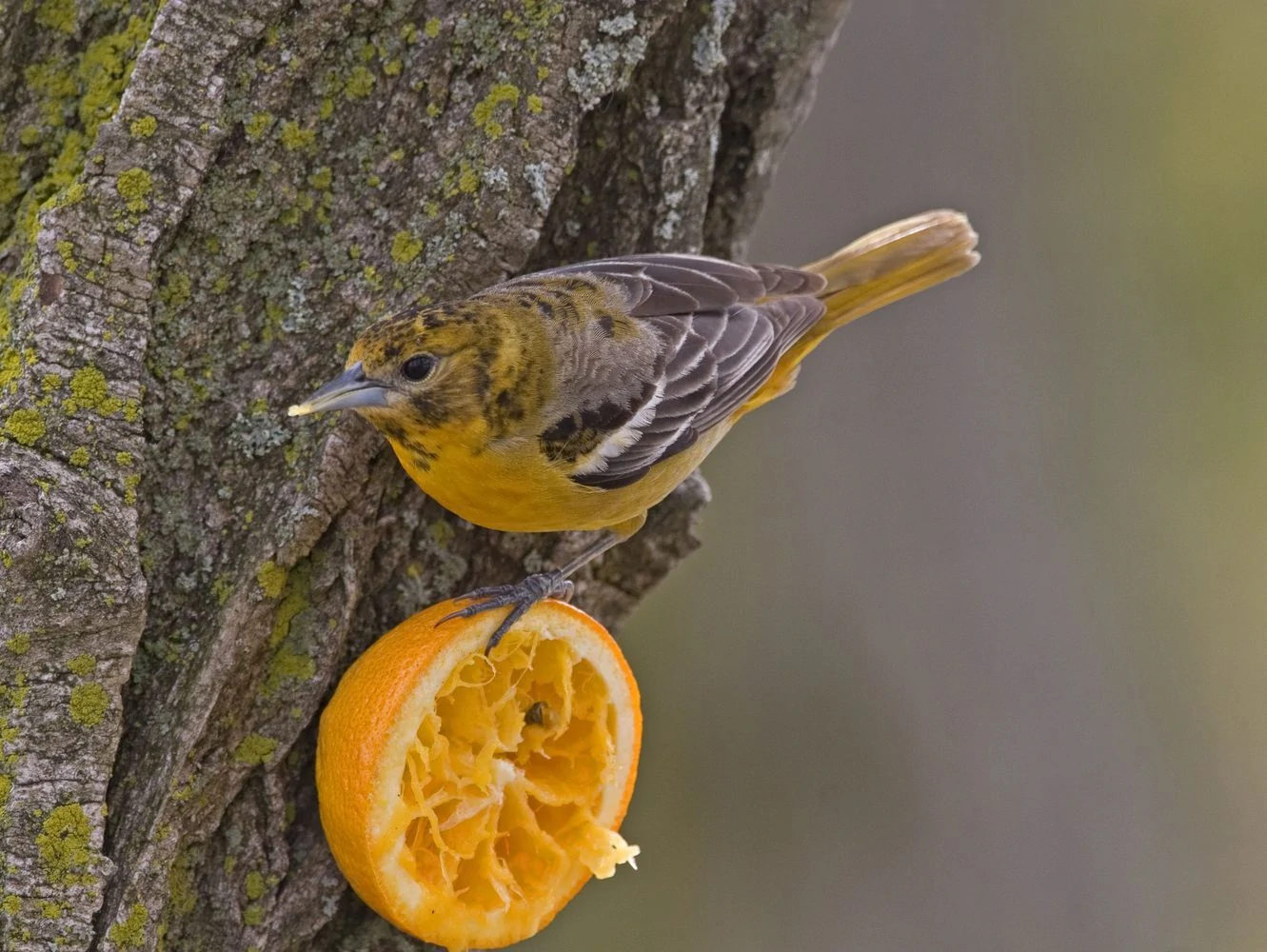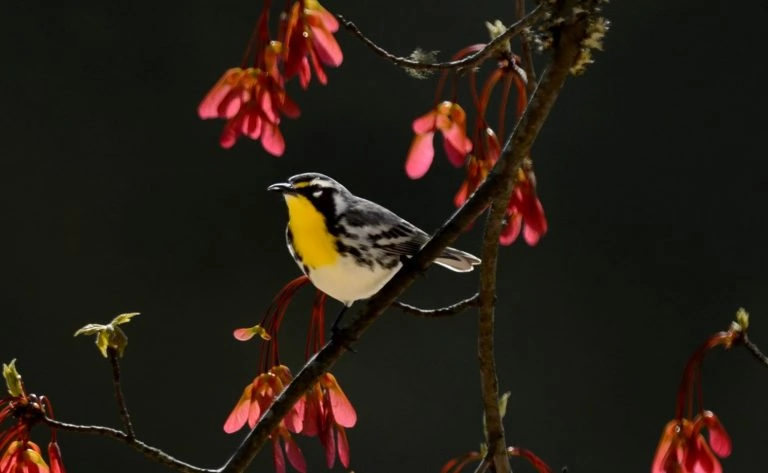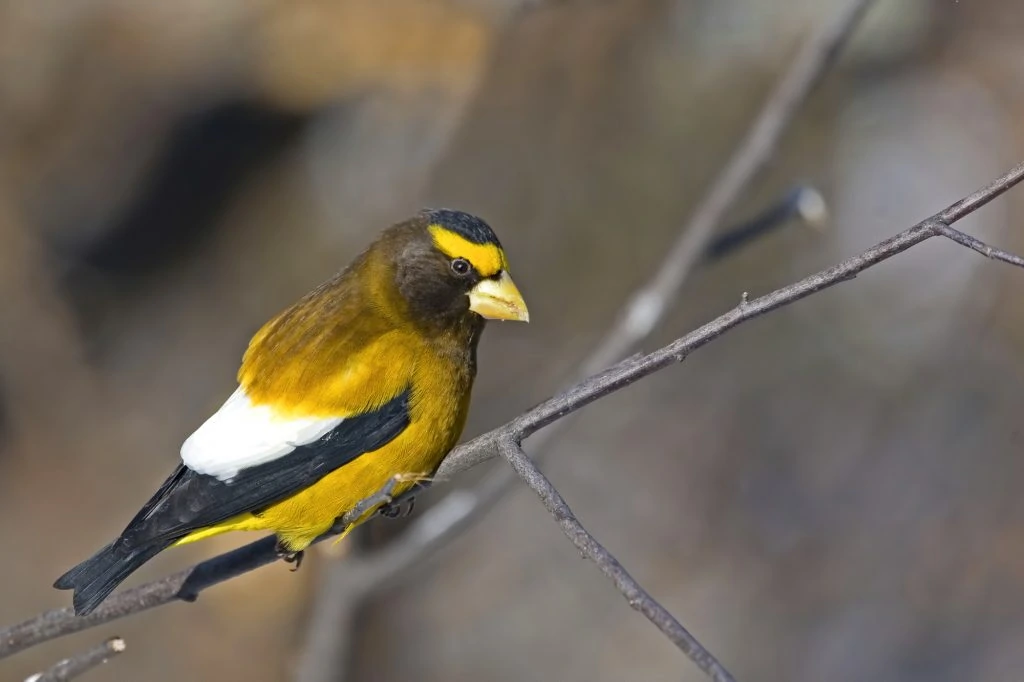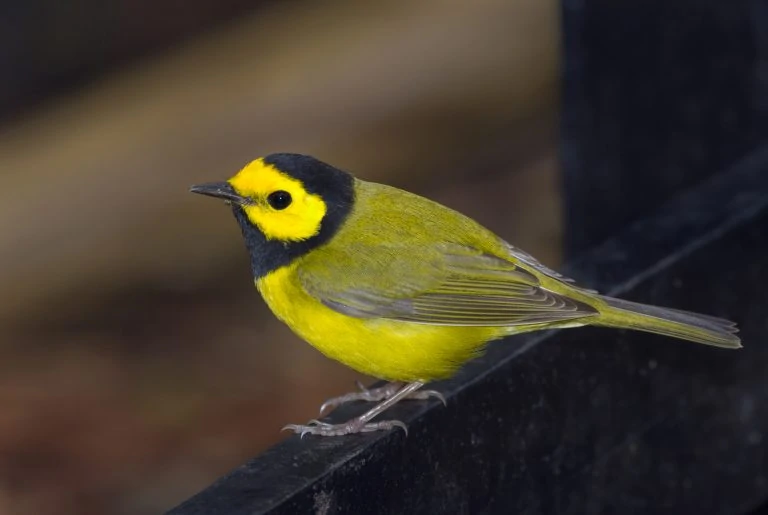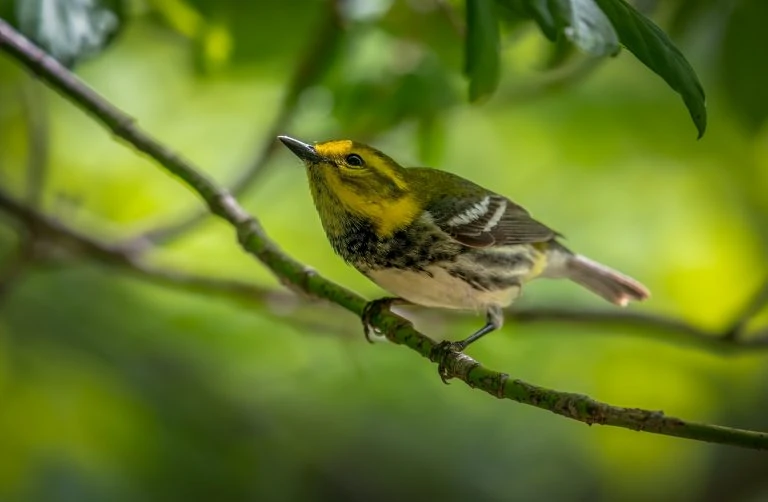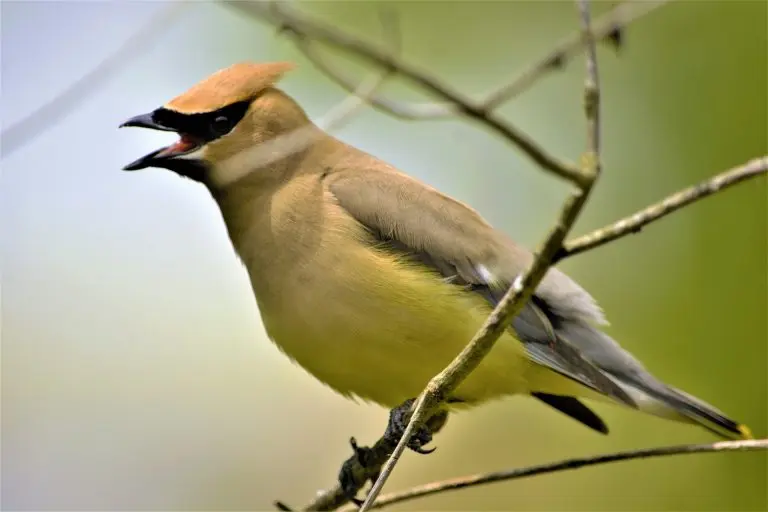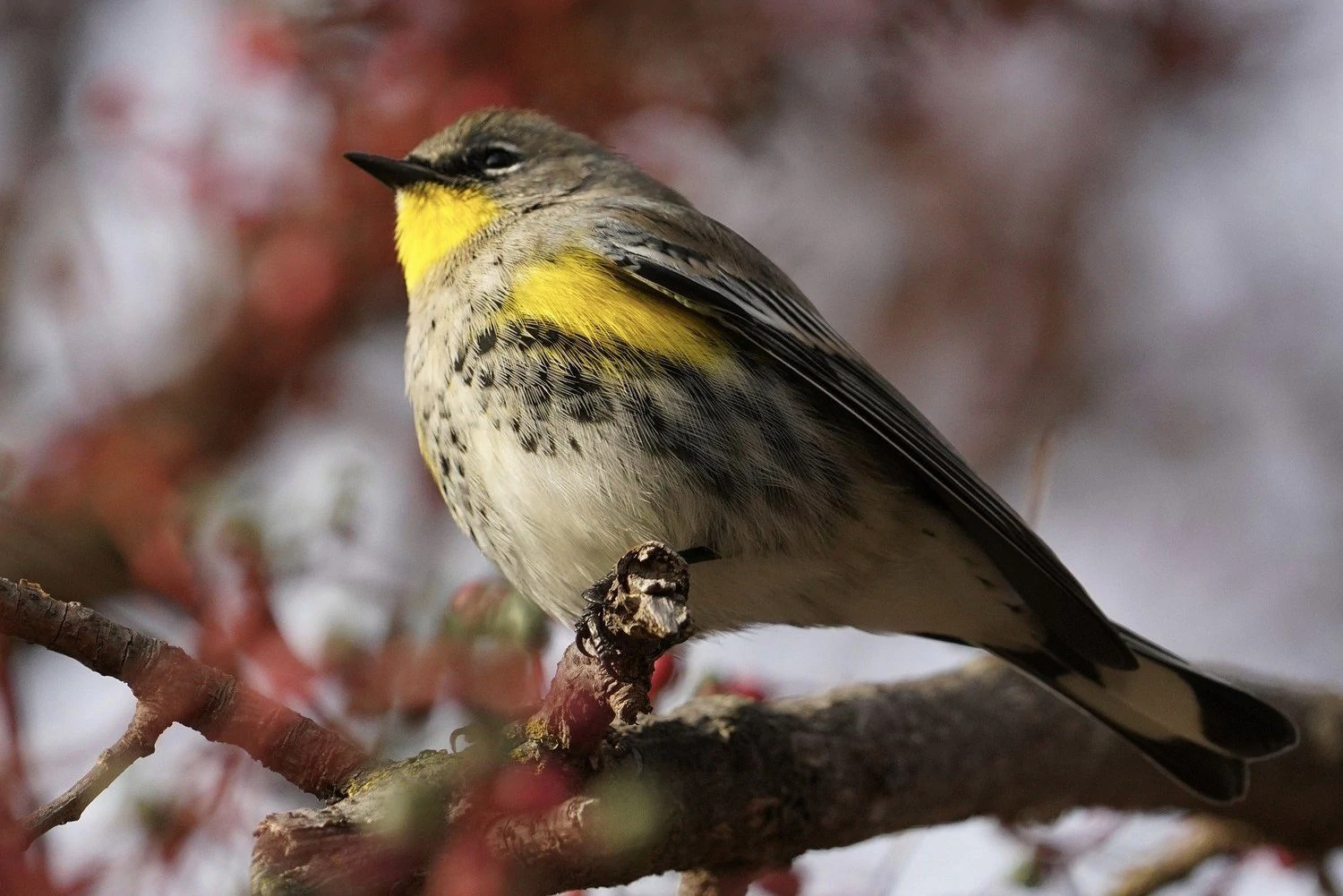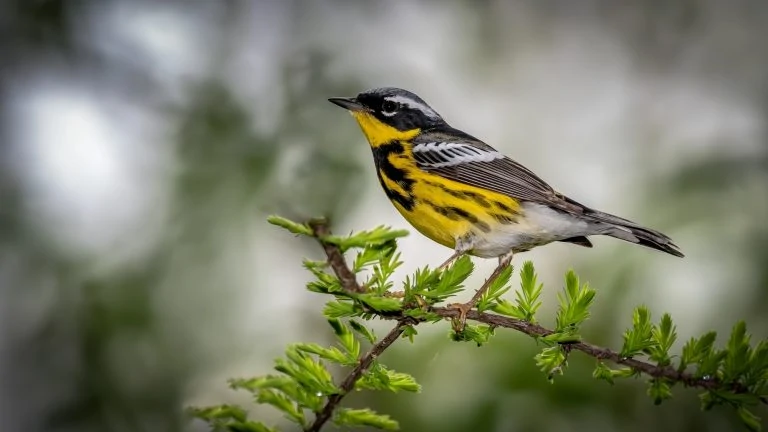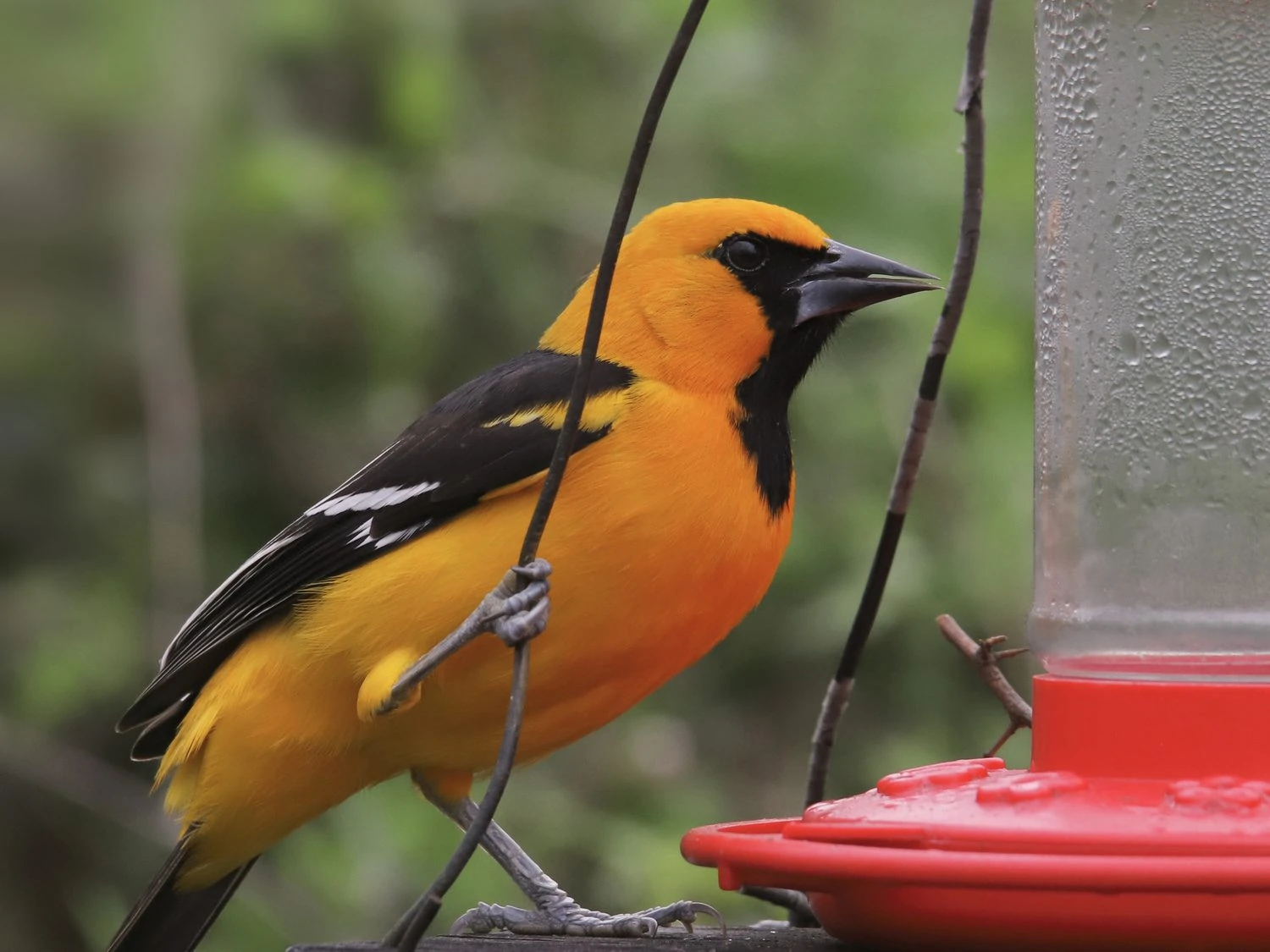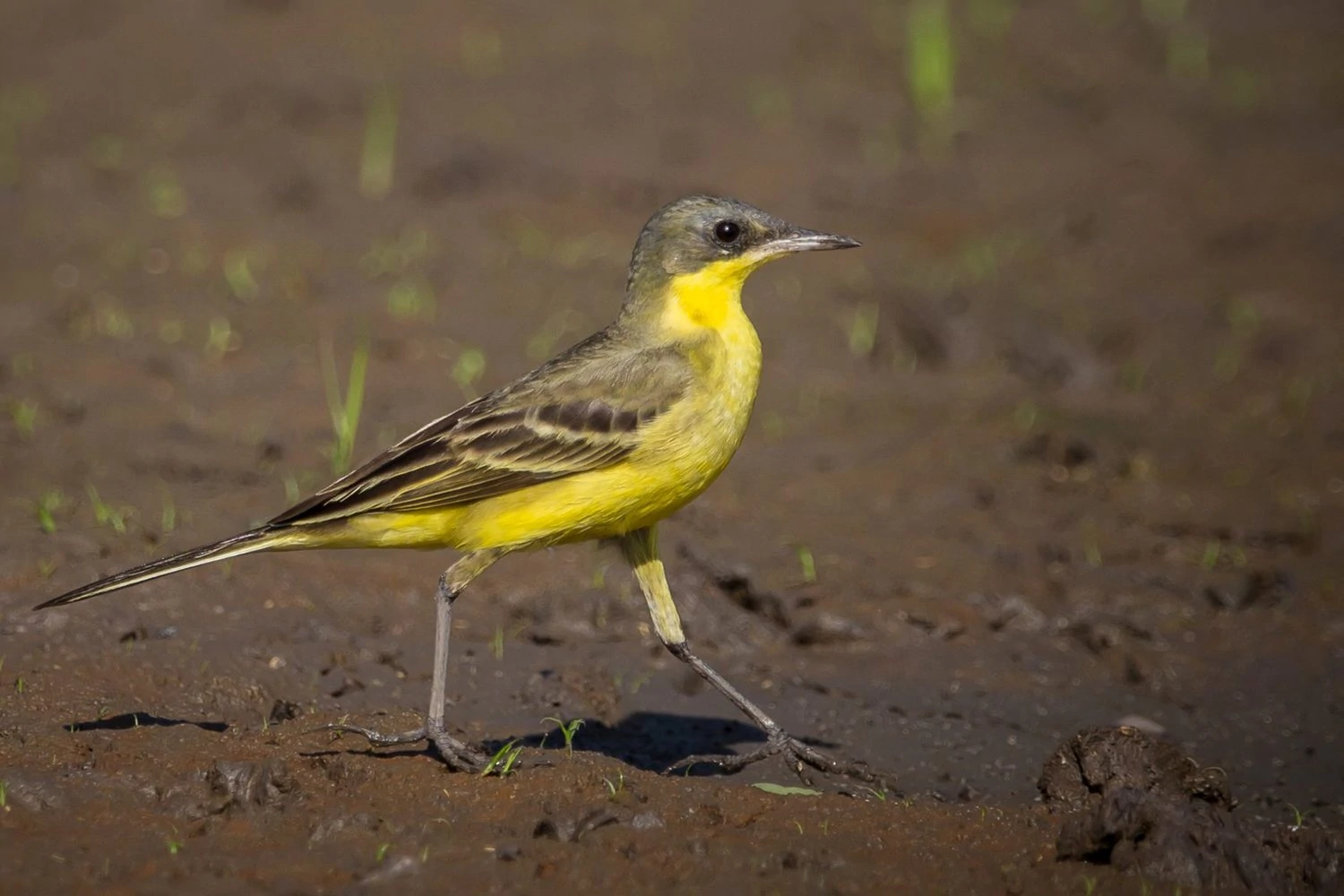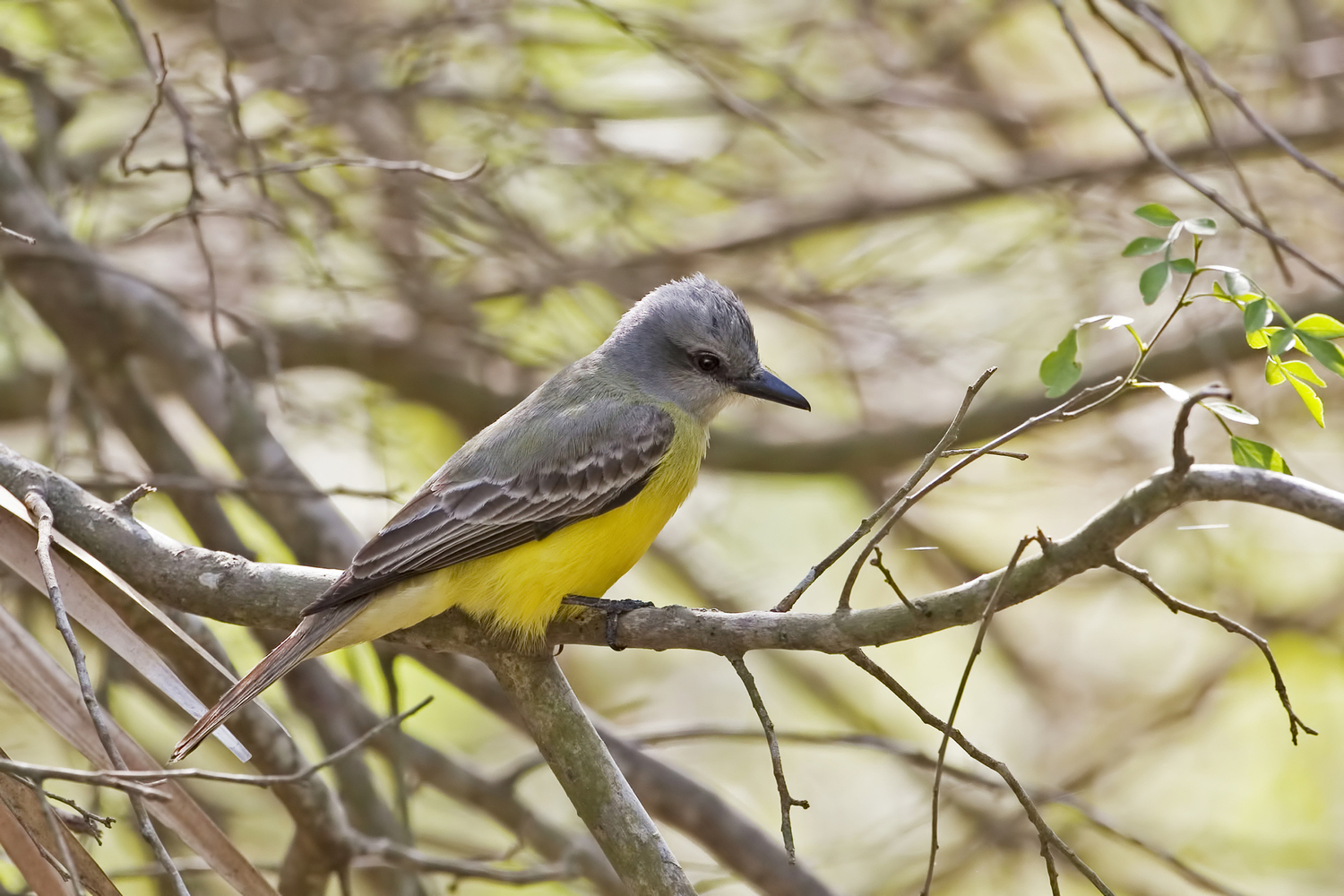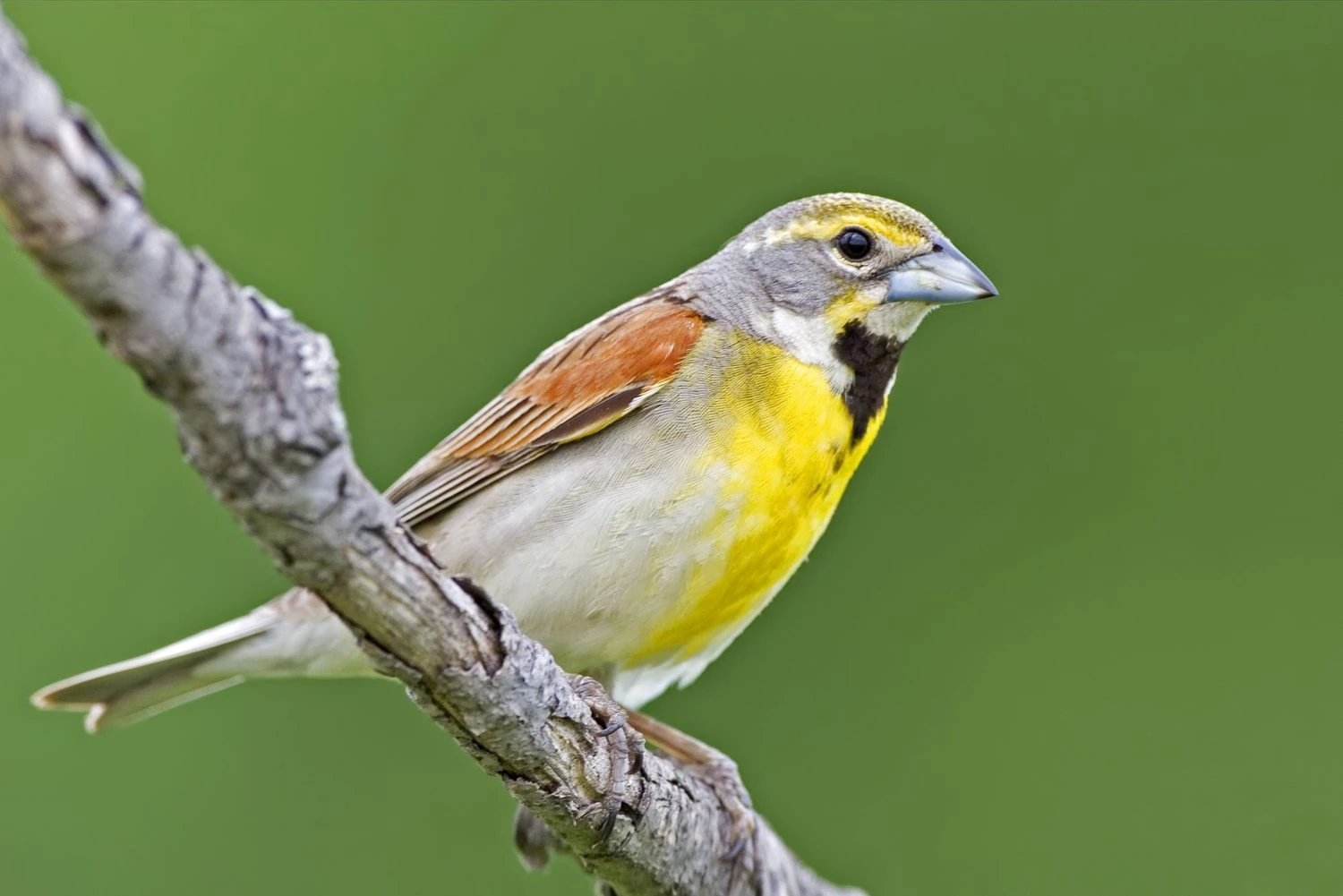Yellow birds come in different types, such as warblers, orioles, and tanagers. It can be helpful to learn about the common yellow birds in your area so you can identify them easily. These birds are usually seen in backyard feeders or out in fields and forests, and they are known for their bright and cheerful appearance. In the US and Canada, there are many yellow birds that visit, some of which migrate while others stay year-round. Generally, yellow birds are more prevalent in the northern states during the summer, as they breed there before migrating south for the winter. To aid in identifying the yellow birds you spot, this guide provides pictures, identification details, song recordings, and migration patterns.
40 Yellow Birds:
1. American Goldfinch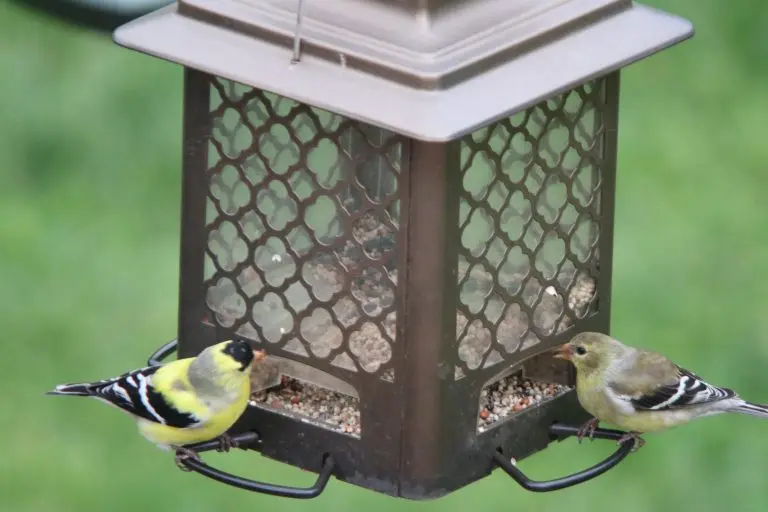
American Goldfinches are a well-liked bird species, especially known for the vibrant yellow and black coloring of the males during springtime. In contrast, the females and males during winter appear more muted, with brown coloring.
Scientifically named Spinus tristis, American Goldfinches measure between 4.3-5.1 inches (11-13 cm) in length, weigh around 0.4-0.7 oz (11-20 g), and have a wingspan of 7.5-8.7 inches (19-22 cm). They are prevalent throughout most of North America and are typically resident throughout the year. However, those that breed in Canada and the Midwest migrate south to US states for the winter season.
American Goldfinches are often found foraging for sunflower, thistle, and aster plants in weedy fields and overgrown areas. They are also commonly spotted in suburban areas, parks, and backyards.
American Goldfinches typically build their nests in shrubs using rootlets and plant materials woven together and held in place with spider webs. They usually lay up to seven eggs, which take around two weeks to hatch. The young remain in the nest for about two to two and a half weeks before leaving.
To attract American Goldfinches to your backyard, you can plant thistles and milkweed. They are known to visit most bird feeders and prefer sunflower or nyjer seeds.
An interesting fact about American Goldfinches is that cowbirds are not successful in getting them to raise their young. This is because American Goldfinches are strictly vegetarian, and cowbird chicks cannot survive on their diet, resulting in death within a few days.
2. Common Yellowthroat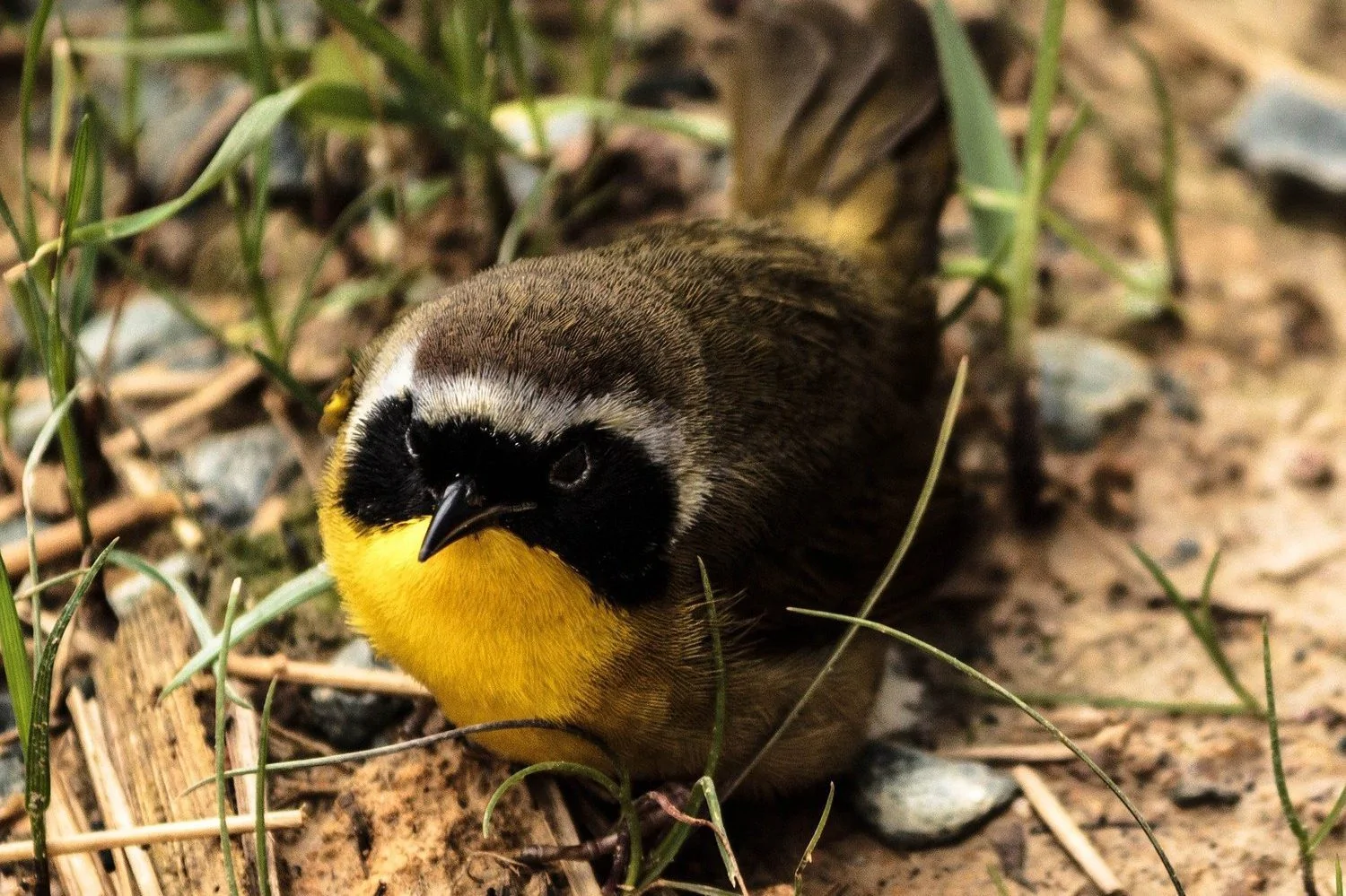
Common Yellowthroats are small songbirds with brownish backs and bright yellow undersides, as well as long tails. The males have black masks across their faces, which are distinct from the females. The brightness of their yellow color can vary depending on their geographic location, with some appearing more olive underneath.
Scientifically named Geothlypis trichas, Common Yellowthroats typically measure between 4.3-5.1 inches (11-13 cm) in length, weigh around 0.3-0.3 oz (9-10 g), and have a wingspan of 5.9-7.5 inches (15-19 cm). They breed during the summer season over most of North America, with the exception of Alaska and northern Canada. Some remain year-round along the Gulf Coast and Pacific Southwest, while others migrate south for the winter season.
Common Yellowthroats are often found in marshy or wetland areas and brushy fields, living in thick, tangled vegetation.
Female Common Yellowthroats typically build their nests near the ground in marshy areas, supported by reeds. The nests are constructed using grass and sedges and held together by a platform of leaves and grass. They lay up to six eggs, which take approximately twelve days to hatch. The young then leave the nest within the same timeframe.
To attract Common Yellowthroats to larger backyards, it’s recommended to have dense vegetation and native plants that can attract insects.
An interesting fact about Common Yellowthroats is that the black mask on the males’ faces is a sign to courting males that the bird is a male. They are known to attack fake birds that have the same mask, but not those that don’t have the mask.
3. Western Meadowlark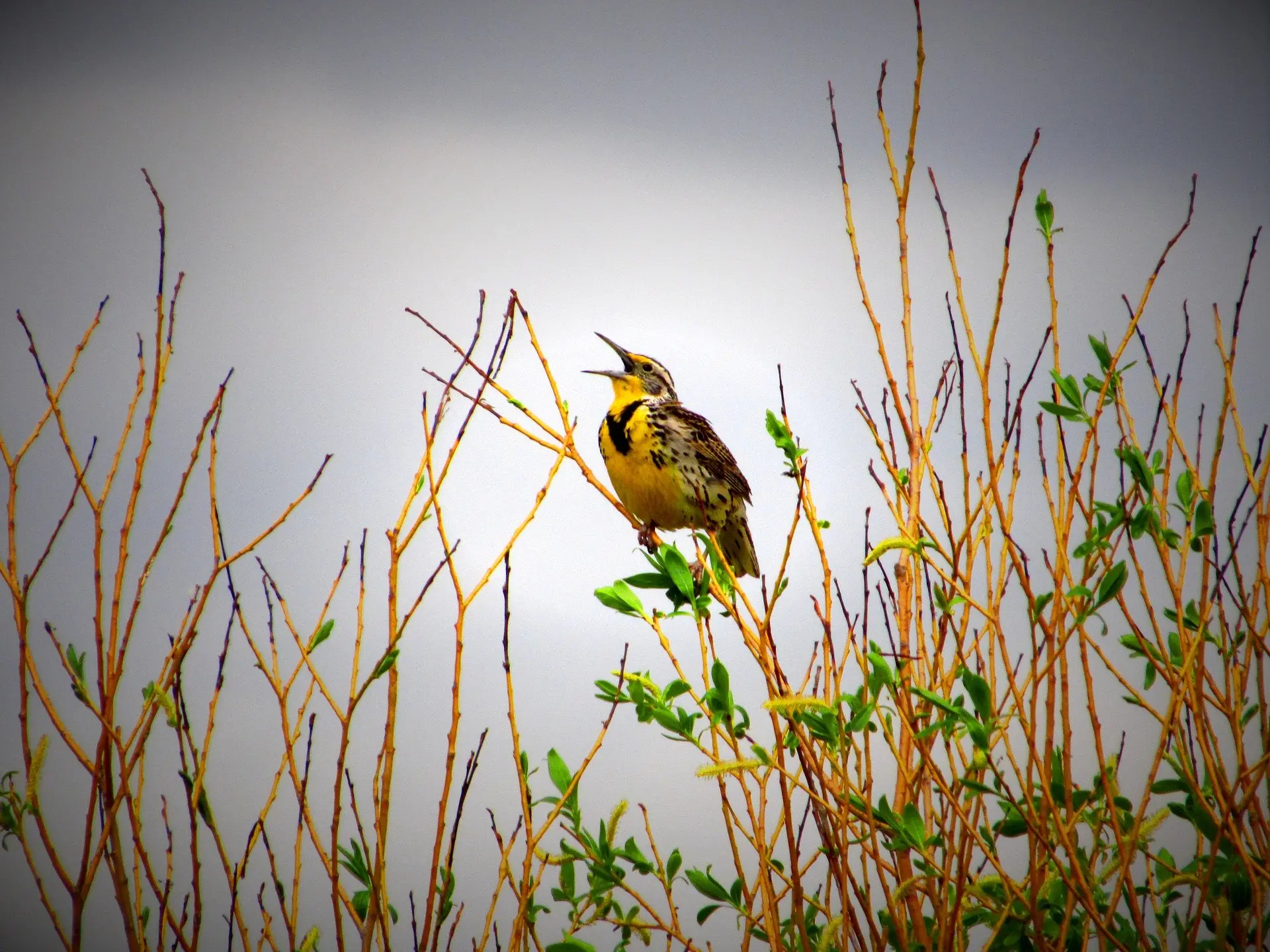
With their vibrant yellow bellies and sweet melodies, Western Meadowlarks can brighten up anyone’s day.
As a member of the blackbird family, Western Meadowlarks are similar in size to robins and have shades of brown and white on their upper parts, with a distinctive black V-shaped band across their bright yellow chest, which turns gray in the winter.
Scientifically named Sturnella neglecta, Western Meadowlarks range from 6.3-10.2 inches (16-26 cm) in length, weigh around 3.1-4.1 oz (89-115 g), and have a wingspan of 16.1 inches (41 cm). Those that breed in the northern US states and Canada migrate to more southern states during the winter, while those in the west and Midwest remain year-round.
Western Meadowlarks are usually found on the ground in grasslands, meadows, and fields. They forage alone or in small flocks and are not typically found in wooded or densely shrubby areas. Their diet mainly consists of insects and seeds, with a preference for insects in the summer and more seeds and grains during the winter.
The Western Meadowlarks’ song consists of a pleasant series of tweets, warbles, and whistles.
Western Meadowlarks typically build their nests in depressions on the ground in grasslands. The nests are lined with soft materials like grass and may also have a roof made from grass and plant stalks.
To attract Western Meadowlarks to your backyard, it’s recommended to use sunflower seeds and cracked corn as bait.
An interesting fact about Western Meadowlarks is that they have been designated as the state bird for six US states.
4. Lesser Goldfinch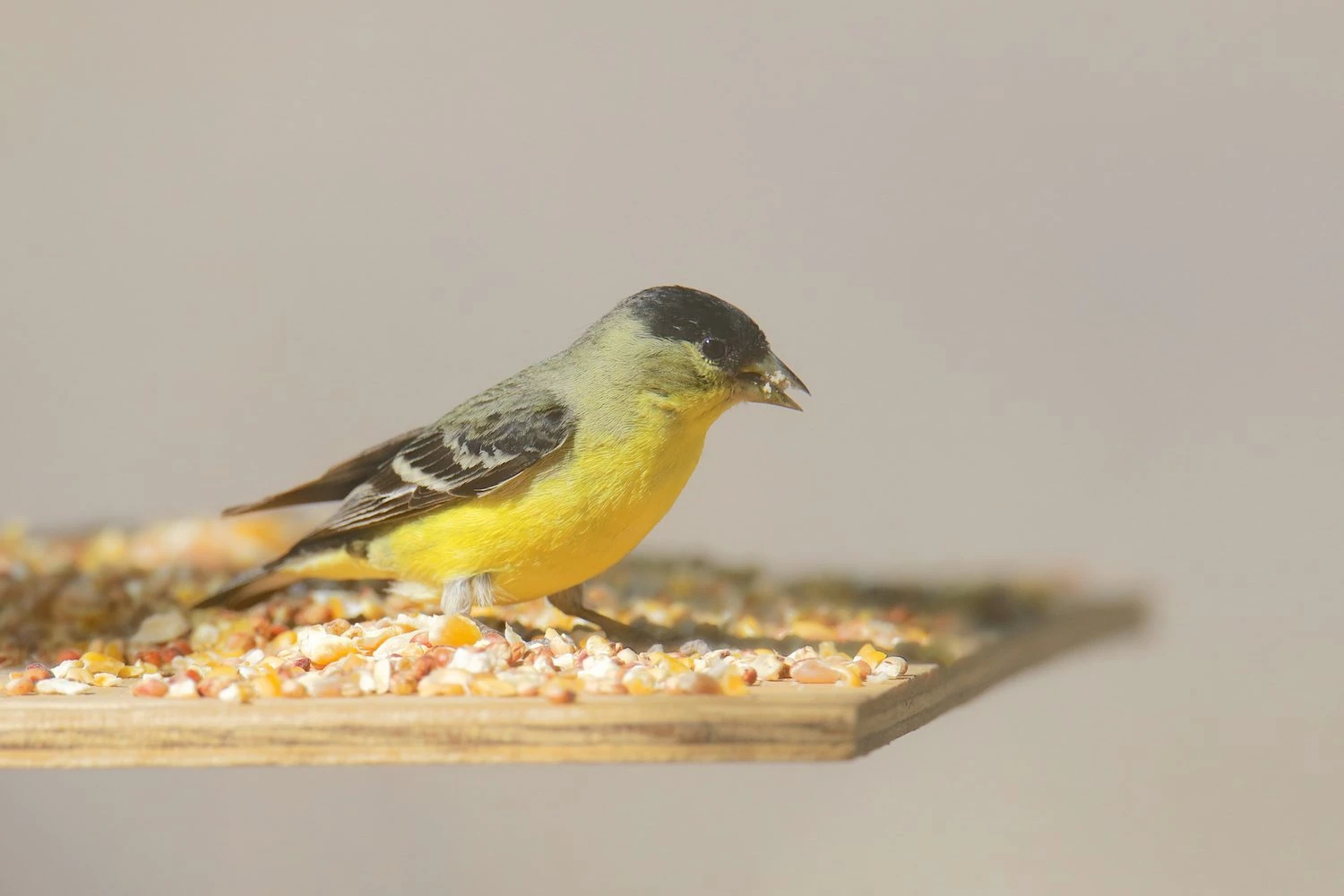
Lesser Goldfinches are small, bright yellow and black songbirds with long pointed wings and short notched tails. Females are similar in color but have olive backs and are more subdued yellow underneath.
Scientifically named Spinus psaltria, Lesser Goldfinches measure between 3.5-4.3 inches (9-11 cm) in length, weigh around 0.3-0.4 oz (8-11.5 g), and have a wingspan of 5.9-7.9 inches (15-20 cm). They reside in southwestern US states and the West Coast year-round, but those that breed in the interior of western US states migrate during the winter season.
Lesser Goldfinches are often seen in large flocks in open habitats, including thickets, weedy fields, forest clearings, parks, and gardens. They forage mainly for seeds, especially sunflower seeds, but also eat fruits from elderberry and coffeeberry, as well as buds from cottonwoods, willows, sycamores, and alders.
The nests of Lesser Goldfinches are usually hidden in trees and shrubs near streams and made from bark, leaves, and other plant materials held together by spider webs. They typically lay up to six eggs, which take about two weeks to hatch, and the young leave the nest within the same timeframe.
To attract Lesser Goldfinches to your yard, you can use sunflower seeds and nyjer in tube or platform feeders.
An interesting fact about Lesser Goldfinches is that their arch-rival is the larger Lawrence’s Goldfinch, and they will chase them away from feeders and nesting areas. However, they will mix with other birds.
5. Prairie Warbler
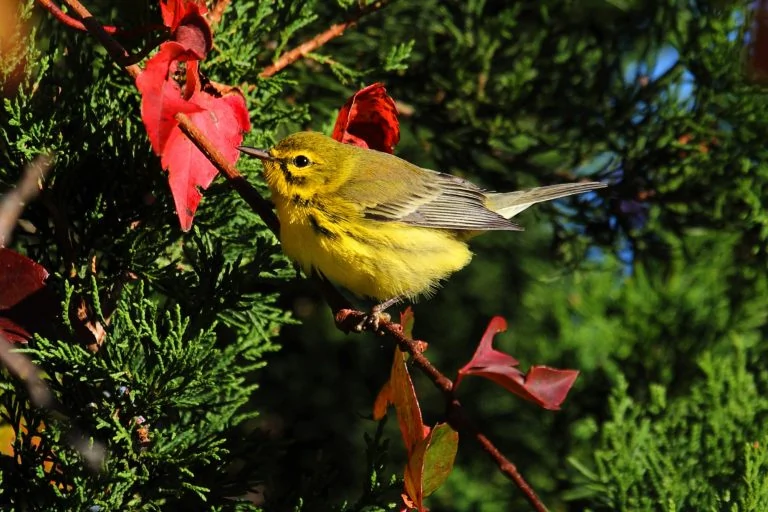
Prairie Warblers are small songbirds with an olive green back and a yellow throat and belly. They have black streaks on their sides and a dark semicircle under their eyes. The females of the species are less colorful than males.
Scientifically named Setophaga discolor, Prairie Warblers are around 4.3 inches (11 cm) in length and weigh around 0.2-0.3 oz (6.4-8.8 g). They breed in eastern and southeastern US states and spend their winters in Florida, the Caribbean, and some coastal areas in Central America. Some remain in Florida throughout the year and are considered a separate subspecies, although they are slightly larger.
Despite their name, Prairie Warblers primarily live in fields and forests, where they feed on insects, spiders, and snails. While searching for food, they can be seen bobbing their tails as they move along branches.
Prairie Warblers construct their nests in trees and shrubs, using plant materials, leaves, and lining them with soft feathers and fur. The female Prairie Warblers lay up to five eggs, which take approximately two weeks to hatch, and the young leave the nest within about ten days.
A fascinating fact about the male Prairie Warbler is that they have two distinct songs that they use. One of the songs is intended to attract females, while the other song is meant to intimidate other male Prairie Warblers.
6. Orange-crowned Warbler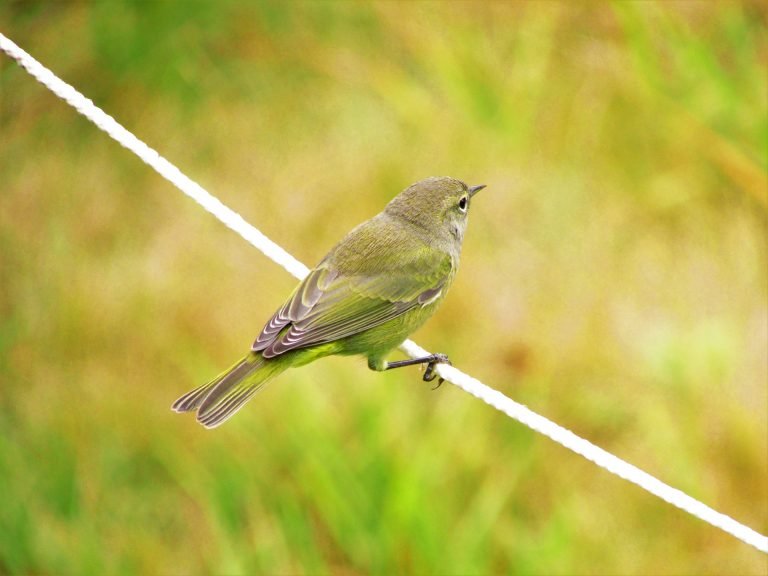
Orange-crowned Warblers are not as vibrantly colored as other warblers. They are mostly yellow-olive in color, which appears more yellow on the Pacific Coast. The orange crown on their head is usually concealed and not visible.
Scientifically named Leiothlypis celata, Orange-crowned Warblers measure between 4.3-5.5 inches (11-14 cm) in length and weigh around 0.3-0.4 oz (7-11 g), with a wingspan of 7.5 inches (19 cm). They breed in Canada and western US states and migrate to the Pacific, East and Gulf Coasts, and Mexico. During migration, they can be seen in all US states except the northeastern ones.
Orange-crowned Warblers can be found in shrubs and low vegetation, but they usually breed in open woodland. Their diet mainly comprises of spiders and insects such as caterpillars and flies. They also eat fruits, berries, and seeds and can often be seen visiting backyard feeders.
The nests of Orange-crowned Warblers are constructed on or near the ground using dead leaves, twigs, and stems, and then lined with soft grass and animal hair. They typically lay up to six eggs.
To attract Orange-crowned Warblers to your yard, you can use suet and peanut butter or hummingbird feeders filled with sugar water nectar.
An interesting fact about Orange-crowned Warblers is that they drink from the sapwells of sapsuckers and woodpeckers.
7. Orchard Oriole Female
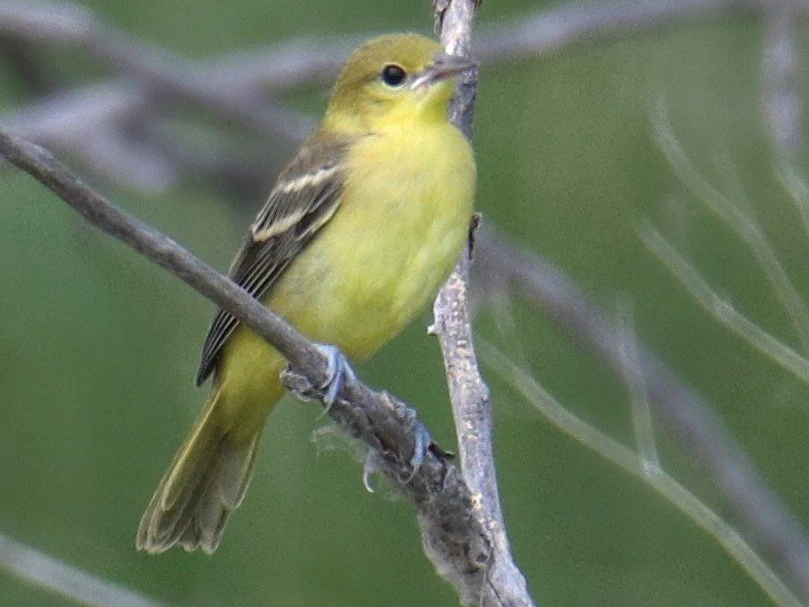
Orchard Orioles are small birds, and the females are overall greenish-yellow in color, paler underneath, and darker on the back. They have darker wings and white wingbars.
Male Orchard Orioles look very different, with bold coloring. They have black heads and backs, and reddish undersides.
Scientifically named Icterus spurius, Orchard Orioles measure between 5.9-7.1 inches (15-18 cm) in length and weigh around 0.6-1.0 oz (16-28 g), with a wingspan of 9.8 inches (25 cm). In the summer, they breed in the eastern half of the United States before migrating south to Mexico and Central America.
Orchard Orioles prefer to live in open woodland and can also be found along river banks, open shrubland, farms, and backyards. They construct hanging pouch-like nests. The primary component of their diet is insects such as ants, caterpillars, beetles, and grasshoppers, as well as spiders. They will also drink nectar from flowers and eat fruits such as mulberries and chokeberries.
The nests of Orchard Orioles are cup-shaped, made from long grasses suspended from small branches of trees. They typically lay 4-6 eggs, which take around two weeks to hatch.
To attract Orchard Orioles to your yard, you can use hummingbird feeders or platform feeders with cut oranges or mango. You can also plant native berry plants such as mulberries or chokeberries.
An interesting fact about Orchard Orioles is that they are the smallest species of blackbird in North America.
8. Western Tanager
Rewritten: Western Tanagers have an eye-catching appearance with their flaming orange-red head, yellow body, and black wings. Female Western Tanagers have a more subtle appearance, with yellow-green bodies and only red faces.
Breeding in western US states and western Canada, Western Tanagers migrate to Mexico and Central America for the winter. They can be seen during migration in the east and south of their range.
Western Tanagers can be found in open conifer forests, but they are known to stay hidden in the canopy despite their bright coloring. Their diet mainly consists of insects during summer, such as wasps and grasshoppers, and fruit during the fall and winter.
The nests of Western Tanagers are built by females in open areas of trees, using large twigs and weaving them into a sturdy cup shape. The nest is lined with soft grass, pine needles, hair, and other plant materials. They lay about four eggs, which take approximately two weeks to hatch.
To attract Western Tanagers to your yard, provide dried fruit, cut oranges, and other fruits from bird feeders.
Fun fact: The red coloring of Western Tanagers comes from eating insects that produce a pigment that they cannot produce themselves.
9. Pine Warbler
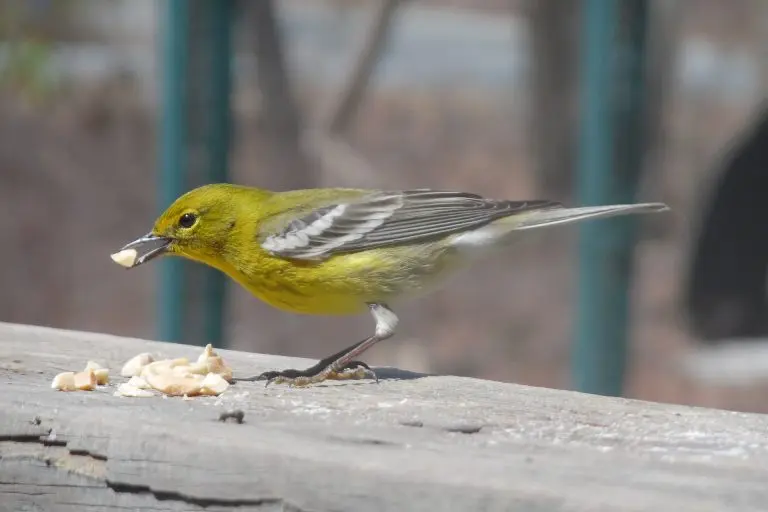
Pine Warblers are a type of small, plump yellow bird with olive-colored backs, white bellies, and gray wingbars. The females may appear browner and have more white on their bellies. They belong to the Setophaga pinus species and can grow up to 5.1-5.5 inches (13-14 cm) in length and weigh between 0.3-0.5 oz (9-15 g), with a wingspan of 7.5-9.1 inches (19-23 cm).
Pine Warblers usually breed in the northeastern United States before migrating to the southeastern states. Some Pine Warblers remain in the southeastern states throughout the year.
Pine Warblers are typically found in pine forests, particularly in the upper parts of trees. They primarily feed on insects such as caterpillars, beetles, spiders, and larvae. During colder weather, they may also eat fruit and seeds.
Pine Warblers are small, round, and yellow birds with olive backs, gray wings, and white bellies. Females may have more brownish coloration and more white on their bellies.
Pine Warblers are around 5 to 5.5 inches long, weigh between 0.3 to 0.5 ounces, and have a wingspan of 7.5 to 9.1 inches. They breed in the northeastern states of the US before migrating south to the southeastern states. Some Pine Warblers do not migrate and instead stay year-round in the southeastern US.
These birds can often be found in pine forests, high up in the trees. They have a varied diet that includes insects such as caterpillars, beetles, and spiders, as well as fruit and seeds during colder weather.
10. Yellow Warbler
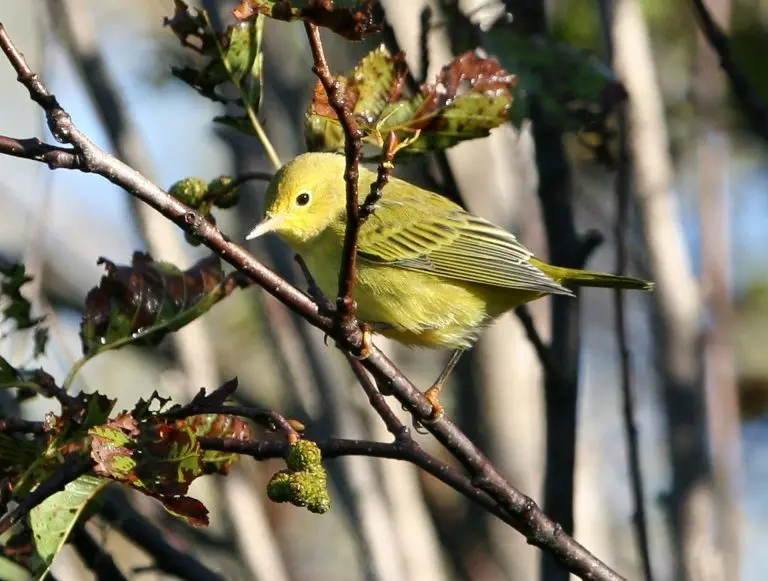
Yellow Warblers are small songbirds that are bright yellow in color, with a yellow-green back, and males have chestnut streaks on their breast. Females and juveniles are less vibrant in color. They breed in Canada and the US, but not in southeastern states, and migrate to Central and South America for winter.
During migration, they can be seen in southeastern states. Yellow Warblers are usually found near streams, wetlands, thickets, and the edges of fields, where they forage for insects like beetles, bugs, caterpillars, midges, and wasps.
Yellow Warblers build their nests in small trees or shrubs using bark, grass, and plant material woven together, secured with spider webs, and lined with softer materials such as hair, feathers, and plant down. They lay up to seven eggs, which take about twelve days to hatch, and the young leave the nest in ten days.
To attract Yellow Warblers to your backyard, you can offer suet, oranges, peanut butter, plants with berries, and birdbaths with fountains near secluded planting areas that provide protection. Additionally, planting native plants that attract insects without pesticides and avoiding tidiness can help. Fun Fact: Yellow Warblers often build a new nest on top of the old one and eggs if cowbirds lay their eggs in their nests, and they can do this up to six times!
11. Western Kingbird
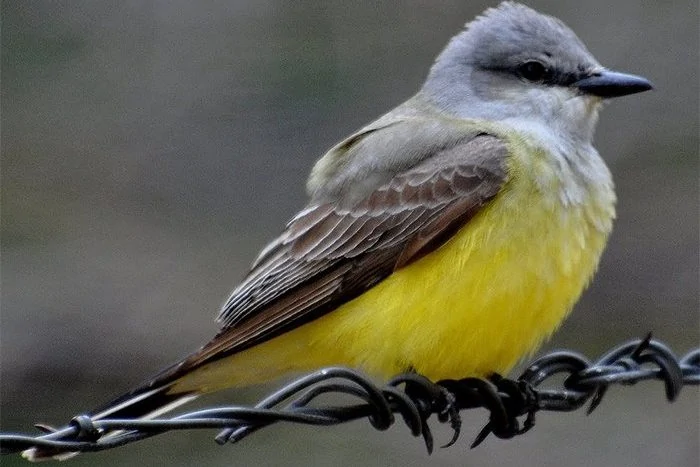
Western Kingbirds are large birds that belong to the flycatcher family. They have yellow bellies, gray heads, grayish-brown wings, whitish chests, and black tails with white edges. During the summer breeding season, Western Kingbirds can be found in western US states, the plains region, and Canada. In winter, they migrate to Mexico and Central America, although some may remain in the southern parts of Florida.
Western Kingbirds are usually found in open habitats, and they perch on fences and utility lines, waiting for insects to fly by, which they catch in mid-flight. They build their nests in trees or shrubs, as well as human-made structures. The female constructs the nest from twigs, grass, and plant material, which are woven together to form a cup.
Western Kingbirds lay up to seven eggs, which take two to three weeks to hatch, and the young remain in the nest for the same duration. If you want to attract Western Kingbirds to your yard, make sure it is insect-friendly and plant elderberry or hawthorn, which they also eat. A fun fact is that Western Kingbird parents will continue to feed their young for three weeks after they have left the nest.
12. Yellow-headed Blackbird
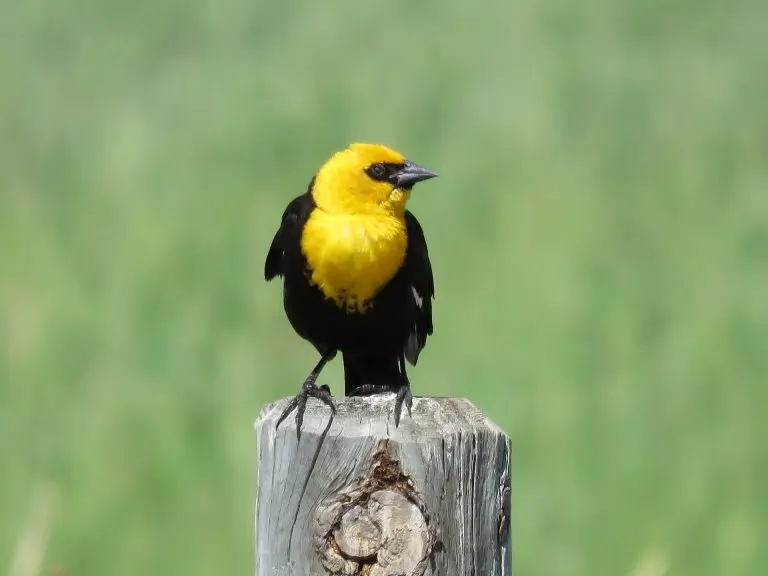
Yellow-headed Blackbirds are visually striking birds, with their glossy black bodies, bright yellow heads, and chests, and white wing patches in males. Females are less conspicuous, with brown rather than black bodies and duller yellow heads. They are larger than the Red-winged Blackbird and can be found breeding in wetlands in western and prairie areas, nesting in reeds.
They mostly forage for insects in the summer, over surrounding wetlands, grasslands, and fields. After breeding, they migrate in large flocks to fields and farmland in Southwest states and Mexico for the winter. During winter, they switch their diet to seeds and grains.
Yellow-headed Blackbirds create their nests by weaving long wet stems together and attaching them to cattails or reeds over the water. They lay 2 to 5 eggs which take about two weeks to hatch, and another week or two before fledging. You can attract Yellow-headed Blackbirds to your yard with sunflower seeds. A fun fact about these birds is that they hunt for insects by flipping over stones to flush them out.
13. White-eyed Vireo
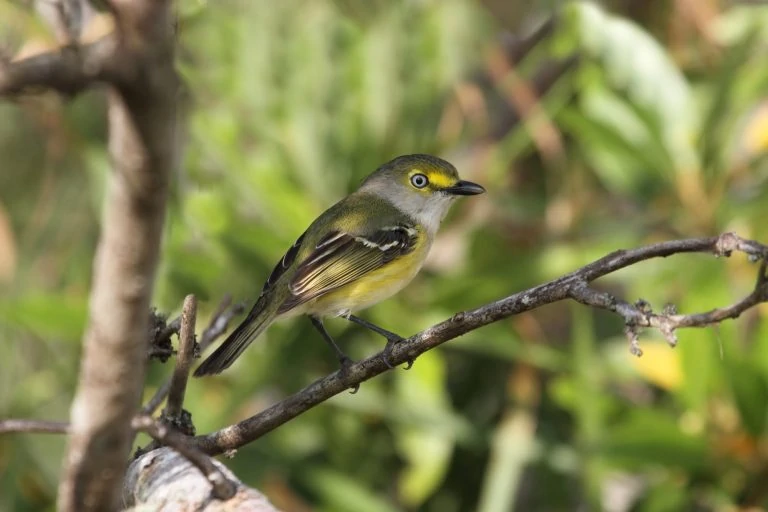
White-eyed Vireos are small birds with gray heads, white throats, and two white wingbars. They have yellow around their foreheads, white eyes, yellow sides, and greenish backs with darker wings.
Vireo griseus Length: 4.3-5.1 in (11-13 cm) Weight: 0.3-0.5 oz (10-14 g) Wingspan: 6.7 in (17 cm)
White-eyed Vireos spend their summers across the southeastern United States, often hidden in thickets. Some near the coast stay there all year, while others migrate to the southeast coast of Mexico and the Caribbean.
White-eyed Vireos can be found in overgrown pastures, brambles, and thickets, where they feed mainly on insects, flies, and spiders. They also eat berries during winter.
The nests of White-eyed Vireos hang from branches in shrubs. They make the initial shape using spiders’ webs and attach leaves, bark, and plant material to form a hanging cup.
White-eyed Vireos lay about four eggs that take two weeks to hatch, and their young leave the nest after ten days.
Fun Fact: During winter, both male and female White-eyed Vireos sing, but only males sing in spring and summer, and they do it from dawn until lunchtime.
14. Baltimore Oriole Female
Nests of Baltimore Orioles are woven from long grass, bark strips, and other plant fibers and are often hung from the tips of branches high up in trees. They lay 3-7 eggs, which take about two weeks to hatch, and the young take about two weeks to leave the nest.
Attract Baltimore Orioles to your backyard with oranges, grape jelly, and nectar feeders, and plant native fruit-bearing trees such as serviceberry or mulberry.
Fun fact: Baltimore Orioles are named after Sir George Calvert, the first Lord Baltimore, who was an early colonizer of Newfoundland and Maryland.
To entice Baltimore Orioles into your backyard, you can use a platform feeder or hang oranges from trees, or even use oriole feeders filled with sugar water. Additionally, planting nectar-rich plants like raspberries, crab apples, and trumpet vines can attract them.
A fun fact about Baltimore Orioles is that they make incredible hanging nests that resemble bags, woven from fibers.
15. Eastern Meadowlark

The Eastern Meadowlark, or Sturnella magna, is a medium-sized songbird, characterized by its vivid yellow underbelly and a back that’s a soft brown, speckled with black markings. Its chest is adorned with a striking black band, which makes it quite distinctive.
These birds, ranging in length from 7.5 to 10.2 inches (19-26 cm), weigh between 3.2 to 5.3 ounces (90-150 g) and have a wingspan measuring between 13.8 to 15.8 inches (35-40 cm).
Throughout the year, Eastern Meadowlarks can be spotted across the eastern regions of the United States. However, during breeding season, they extend their territory to the Northeast and Canada, only to journey southwards when the season ends.
The arrival of spring in the East is signaled by the vibrant display and harmonious melodies of the Eastern Meadowlark. Despite their heartwarming presence, these songbirds are unfortunately listed as near-threatened.
Inhabiting grasslands and prairies, these birds are typically seen on the ground, where they feast on insects. In the winter, they assemble in large groups in fields, foraging for seeds.
The nests of the Eastern Meadowlarks are ground-based marvels, complete with tunnels and roofs, all intricately woven from grass.
An intriguing trivia about these birds: Eastern Meadowlarks are known to have a repertoire of over a hundred different songs.
16. Yellow-throated Warbler
Boasting bodies of gray and white accented by black stripes, Yellow-throated Warblers stand out with their vivid yellow throats. Viewed from underneath, their bellies and tails appear white. The coloration is more subdued in females and juveniles.
These birds, known scientifically as Setophaga dominica, are moderately sized, with a length of 5.1-5.5 inches (13-14 cm), a weight of 0.3-0.4 ounces (9-11 g), and a wingspan of 8.3 inches (21 cm).
Yellow-throated Warblers have their breeding grounds across the southeastern regions of the United States. During winter, they migrate to Florida, the Caribbean, and the Gulf Coast, extending into Central America. Some of these warblers even choose to be permanent residents of Florida.
You can typically spot these birds at the highest points of pine trees where they hunt for insects. However, during their migration period, they may be seen lower in the trees.
Their nests are remarkable structures, ingeniously built in the Spanish moss that hangs from tree branches. The warblers craft a pocket in the moss and weave grasses, weeds, and more moss into a cup-like nest. Typically, they lay around four eggs, which take up to two weeks to hatch.
To lure Yellow-throated Warblers into your backyard, consider planting native flora and maintaining wild, unmanicured sections in your yard.
An interesting tidbit: Yellow-throated Warblers are among the few bird species whose population has seen a rise in recent years. Despite an initial decline and a shrinkage in their range, they have managed to increase their numbers by 50% since 1966.
17. Palm Warbler
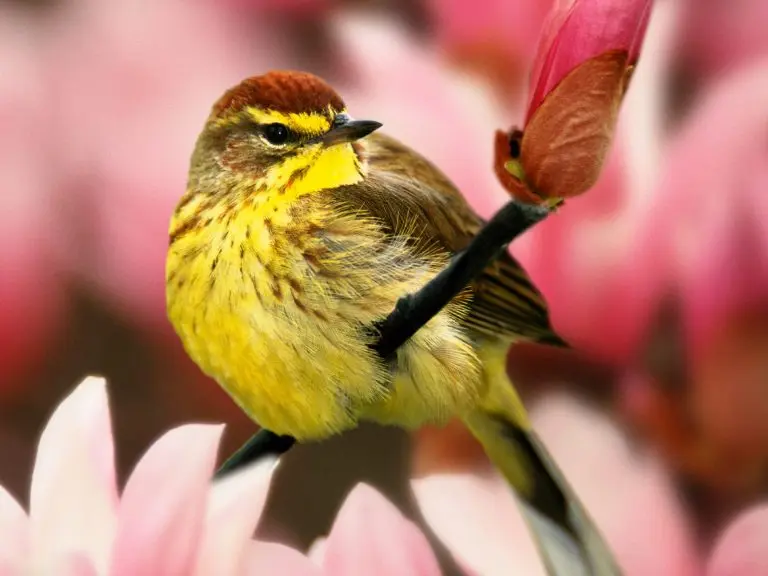
The Palm Warbler, distinguished by a rich red patch atop its head and a body clothed in a blend of brown and olive hues, is a remarkable sight. While these birds breed in Canada, they journey to the eastern United States during migration and are year-round residents of the far southern coast and Florida.
Known scientifically as Setophaga palmarum, these birds are on the smaller side, with a length ranging from 4.7 to 5.5 inches (12-14 cm), a weight of 0.3 to 0.5 ounces (7-13 g), and a wingspan between 7.9 to 8.3 inches (20-21 cm).
Palm Warblers, which breed primarily in Canada, can be seen in the eastern US states during migration, with some choosing to winter in Florida and along the southeastern coastline.
During the spring and fall migration, Palm Warblers can usually be seen in weedy fields, on the fringes of forests, and in scrubby areas. They are often spotted foraging for insects on the ground, mingling with other bird species such as Sparrows, Juncos, and Yellow-rumped Warblers.
Palm Warblers build their nests on the ground in bogs and boreal forests. Their nests are intricate structures made from grass, sedge, and ferns, woven into a cup shape and lined with soft grass, feathers, and animal hair. Typically, they lay about five eggs.
To attract Palm Warblers to your backyard, consider incorporating native plants that are known to attract insects. Planting bayberry or hawthorn can also be beneficial due to their berry offerings.
A fun fact about these birds: Unlike most warblers, Palm Warblers have a unique habit of bobbing their tails as they walk on the ground in search of insects.
18. Evening Grosbeak
Evening Grosbeaks are robust birds characterized by their large bills and striking yellow and black coloration. The adult males sport a vibrant yellow stripe over their eyes, adding an intense look to their black heads. They have gray necks and yellow chests and bellies, along with a unique white patch on their wings.
Females and younger males display greenish bills, predominantly gray bodies, black and white wings, and a yellowish tint around their necks.
Known scientifically as Hesperiphona vespertina, these birds measure between 16 to 22 cm (6.3 to 8.7 in) in length and weigh around 38.7 to 86.1 g (1.37 to 3.04 oz). Their wingspan ranges from 30 to 36 cm (12 to 14 in).
Evening Grosbeaks are primarily residents of southern Canada and the western coast down to northern California throughout the year. Nevertheless, when their food source, cone crops, is scarce, they migrate southwards, reaching most US states.
These birds are typically found in forests and mountainous areas. During the winter, they are often seen around backyard bird feeders due to the easy availability of food.
Evening Grosbeaks have a varied diet, feeding on flower buds in the spring, insect larvae from treetops in the summer, and flocking to backyard feeders or dining on seeds, berries, and small fruits in winter.
Their nests, often located up to 100 feet above the ground in pine trees, are loosely constructed with twigs, rootlets, grass, moss, and pine needles. The female typically lays up to five eggs and incubates them for two weeks until they hatch.
To draw Evening Grosbeaks to your backyard during winter, consider offering sunflower seeds, berries, and maple buds.
An interesting fact about these birds is their powerful bills. They can crack open seeds that are too tough for smaller birds, who then gather around to feast on the leftover fragments.
19. Scott’s Oriole
Scott’s Orioles are large, eye-catching birds. Males are characterized by their black heads and backs, bright yellow bellies, and black tips on their tails. Females, on the other hand, display a more subdued yellow hue with olive-brown backs.
Scientifically known as Icterus parisorum, these birds measure about 9.1 inches (23 cm) in length and weigh between 1.1 and 1.4 ounces (32-41 g). Their wingspan extends to approximately 12.6 inches (32 cm).
These orioles breed in the southwestern regions of the United States and northern Mexico, after which they migrate south for the winter. Some of them remain year-round in southern Mexico and Baja California.
Scott’s Orioles can usually be spotted on higher slopes in dry areas, where they feed on insects, nectar, and fruit. They are commonly found on yucca plants and are known to start their melodious singing before the break of dawn.
The nests of these orioles are quite low, usually situated at heights of 5 to 7 feet. They build their nests using a variety of materials, including cactus fibers, grass, and yucca leaves, creating a basket-like structure. They are quite prolific, often having two to three broods in a year.
To draw Scott’s Orioles to your backyard, consider providing sugar water, jelly, and oranges.
An interesting fact about these birds is their ability to feed on toxic monarch butterflies. They have developed a strategy to identify and consume those butterflies that carry the least amount of toxins.
20. Hooded Oriole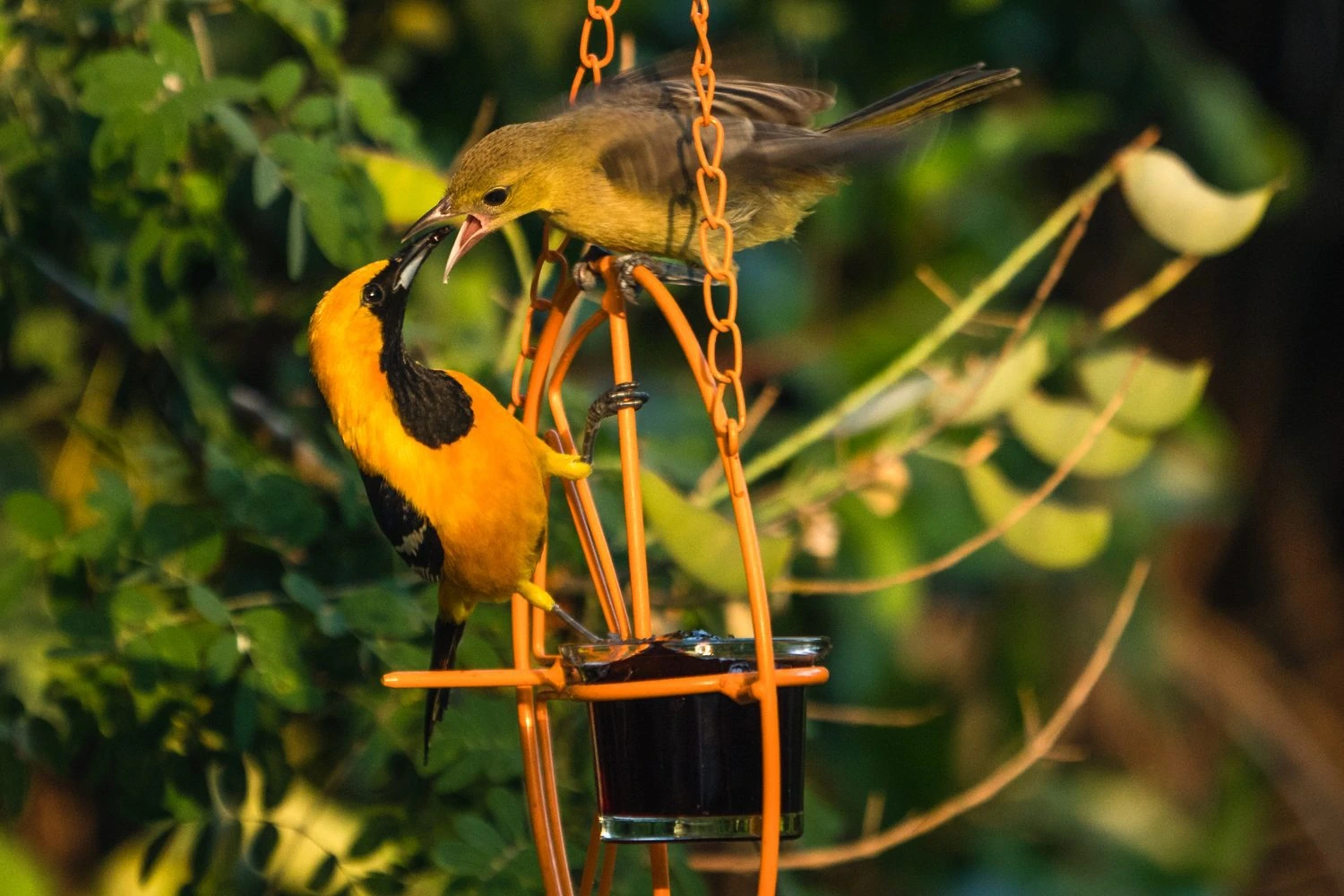
Hooded Orioles are quite the sight, with males boasting vibrant hues that range from sunny yellow to fiery orange, coupled with black throats and backs. Females and immature birds present a more subtle palette, being predominantly yellow with grayish wings. Unlike the males, females don’t have the black facial markings.
This species, known scientifically as Icterus cucullatus, measures between 7.1 to 7.9 inches (18-20 cm) in length, weighs around 0.8 ounces (24 g), and has a wingspan varying from 9.1 to 11.0 inches (23-28 cm).
These birds breed in the southern regions of the United States, crafting their hanging nests under palm fronds. During winter, they migrate to Mexico, but some choose to stay year-round on the Gulf Coast of Mexico and Central America.
Interestingly, some Hooded Orioles have ceased their migratory habits in southern US states, thanks to the readily available food supply from birdwatchers, including nectar feeders and fruits. They typically inhabit dry, open spaces, with a particular fondness for palm trees.
Their nests are often constructed high up, about 20 feet above the ground. These nests are hanging baskets, skillfully woven from grass and plant materials.
To attract Hooded Orioles to your backyard, you can provide sugar water, jelly, and oranges.
Here’s a fun fact: The color of male Hooded Orioles varies by location. Those found in Texas lean towards orange, while their counterparts further west display a yellow hue.
21. Wilson’s Warbler

Wilson’s Warblers are small, round, yellow birds characterized by a prominent black cap in males and a less pronounced one in females.
Cardellina pusilla Length: 3.9-4.7 in (10-12 cm) Weight: 0.2-0.3 oz (5-10 g) Wingspan: 5.5-6.7 in (14-17 cm)
These warblers have their breeding grounds in Canada, Alaska, and the northwestern regions of the United States, but they can be sighted across all US territories during their migration. Their winter homes are found in Mexico and Central America.
Typically, Wilson’s Warblers can be found near forest edges and along streams within thickets, where they search for insects, spiders, and their larvae for sustenance.
Nests of these warblers are artfully camouflaged on the ground, nestled close to trees or shrubs. The base of their nests is made from leaves and sedges, while grass, bark, moss, and other plant materials are intricately woven to form a cup shape, lined with soft grass and animal hair for added comfort. They lay around five eggs, which take approximately eleven days to hatch, and another ten days for the fledglings to venture out of the nest.
While these warblers do not typically visit feeders, you can attract them to your backyard by planting native trees and shrubs.
Fun Fact: Wilson’s Warblers employ a clever tactic to deter potential nest predators. They pretend to have a broken wing, leading the predator away from their nest, only to take flight when they’ve successfully distracted the threat.
22. Hooded Warbler
Sporting a vivid yellow face, contrasting black hood and throat, the male Hooded Warblers are unmistakable. Their underbelly is a bright yellow, while the backside presents an olive-green shade. A distinctive white underside of their tail becomes noticeable when they lift their tails.
Female and younger Hooded Warblers lack the black facial markings and showcase a more subdued yellow tone.
Species: Setophaga citrina Length: Approximately 5.1 in (13 cm) Weight: Roughly 0.3-0.4 oz (9-12 g) Wingspan: Around 6.9 in (17.5 cm)
These birds breed primarily in the eastern regions of the United States, migrating to Central America and the Caribbean during the winter season.
Habitually, Hooded Warblers can be spotted in thickly vegetated forests, busily hunting insects and spiders.
The nests of these Warblers are typically positioned near forests or clearings and are constructed in shrubs using materials such as bark, grass, and plant matter woven into a cup-like structure. They usually lay about four eggs, which hatch after twelve days, and the fledglings leave the nest after about nine more days.
To attract Hooded Warblers to your backyard, consider incorporating native shrubs and plants that attract insects, as these provide both food and shelter.
Fun Fact: Hooded Warblers possess white spots on their tails, a feature believed to startle insects, thereby making them easier prey.
23. Black-throated Green Warbler
Black-throated Green Warblers are petite, vibrant yellow songsters boasting a yellow face and head, along with an olive-yellow back. Their sides and wings display black streaks, and their undersides have a whitish hue. Males are distinguished by prominent black patches on their throats, which are smaller in females and young ones.
Species: Setophaga virens Length: Approximately 4.3-4.7 in (11-12 cm) Weight: Roughly 0.3-0.4 oz (7-11 g) Wingspan: Around 6.7-7.9 in (17-20 cm)
During their extensive migration, Black-throated Green Warblers traverse across the eastern US, making their way to the breeding sites in the northeastern US and Canada. Their winter retreats are located in Mexico, northern parts of South America, and the Caribbean.
These Warblers prefer higher elevations in forests, feeding predominantly on insects. Their black throats serve as a clear distinguishing feature amidst other small yellow birds.
Their nests are strategically built in small trees near the trunk, constructed from twigs and bark. This structure is held together with spider webs and lined with animal hair, moss, and feathers. Typically, they lay about four eggs, which take approximately twelve days to hatch, and another ten days for the fledglings to vacate the nest.
If you want to lure Black-throated Green Warblers into your backyard, planting mature trees would be beneficial.
Fun Fact: A testament to their vocal prowess, male Black-throated Green Warblers can belt out songs over 400 times within an hour. They also engage in a triumphant flight display after successfully warding off competitors.
24. Cedar Waxwing
Cedar Waxwings are sophisticated, sociable birds featuring a pale brown hue on their head, chest, and crest that subtly transitions to gray on their back, wings, and tail. Their underbelly is a soft yellow, with a striking yellow tip. These birds are characterized by a slim black mask around their eyes and vivid red accents on their wingtips.
Species: Bombycilla cedrorum Length: Approximately 5.5-6.7 in (14-17 cm) Weight: Roughly 1.1 oz (32 g) Wingspan: Around 8.7-11.8 in (22-30 cm)
Cedar Waxwings primarily breed in Canada, later migrating to the southern US, Mexico, and Central America to escape the winter chill. However, they are year-round inhabitants in the northern US.
These birds can typically be spotted in berry bushes, woodlands, grasslands, urban areas, and alongside streams. While they have a preference for fruit, they also consume insects during the summer months.
Cedar Waxwings construct their nests in trees using materials like twigs, grass, hair, and various plant debris, lining them with pine needles and soft grass. They lay up to six eggs, which take roughly twelve days to hatch. The chicks then take about sixteen more days to be ready to leave the nest.
To entice Cedar Waxwings into your backyard, consider planting native trees and shrubs that bear small fruits such as serviceberry, dogwood, juniper, winterberry, and hawthorn. Offering fruit on platform feeders might also attract them.
Fun Fact: During courtship, Cedar Waxwings engage in a charming ritual where they exchange gifts with their potential partners.
25. Yellow-rumped Warbler
Yellow-rumped Warblers are predominantly gray birds characterized by vibrant yellow markings on their faces, sides, and rumps, as well as distinct white patterns on their wings.
Females may have a slightly brownish hue, while their winter plumage leans towards a paler brown with striking yellow rumps and sides. With the arrival of spring, they transform, their bright yellow and gray hues re-emerging.
Species: Setophaga coronata Length: Approximately 4.7-5.5 in (12-14 cm) Weight: Roughly 0.4-0.5 oz (12-13 g) Wingspan: Around 7.5-9.1 in (19-23 cm)
Yellow-rumped Warblers primarily breed in Canada, the Rockies, and parts of the Appalachian mountains. During migration, they can be spotted in the Midwest, and they overwinter in the southern and southwestern US states, along the Pacific Coast, and extending into Mexico and Central America.
These birds inhabit coniferous forests, particularly during the breeding season. In winter, they frequent open areas abundant with fruiting shrubs. Their diet comprises mainly insects in the summer and fruits, including bayberry and wax myrtle, during migration and winter.
Females build nests in conifer trees using twigs, pine needles, and grass, lining them with softer grass, moss, and hair. They lay up to six eggs, which take around two weeks to hatch. The fledglings take about another two weeks to leave the nest.
To attract Yellow-rumped Warblers to your backyard, consider providing sunflower seeds, suet, raisins, and peanut butter.
Fun Fact: Yellow-rumped Warblers often form large flocks of thousands during the winter months. They can be quite territorial, showing aggression towards other species that come too close.
26. Summer Tanager Female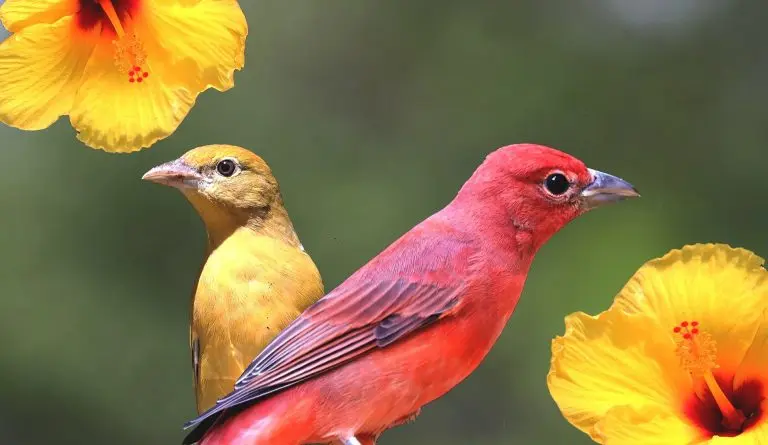
Summer Tanager males are characterized by their vibrant red plumage and robust, sizeable beaks. Females and young ones lean more towards a yellow shade, with a touch of green gracing their backs.
Species: Piranga rubra Length: Roughly 6.7 in (17 cm) Weight: Approximately 1.1 oz (30 g)
These birds breed in the southern and eastern states of the US, migrating to Central and South America when winter sets in.
Summer Tanagers can typically be spotted in open woodlands, exhibiting a fascinating feeding habit. They are adept at catching bees and wasps mid-flight, skillfully beating them against a branch to kill them, and carefully rubbing off the stinger before consumption.
The females build the nests, which are usually situated towards the ends of overhanging branches. Constructed from grass and various plant materials, these nests may not be particularly sturdy, but they manage to accommodate around four eggs. The incubation period lasts approximately ten days, and it takes the fledglings another ten days or so to leave the nest.
To attract Summer Tanagers to your backyard, consider planting berry bushes and fruit trees.
Fun Fact: After leaving the nest, young Scarlet Tanagers continue to be fed by their parents for an additional three weeks. This is because their flight skills take a few more weeks to fully develop.
27. Streaked-backed Oriole Juvenile
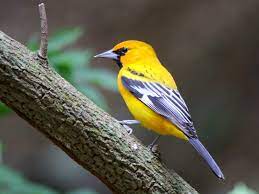
Streak-backed Orioles in their juvenile phase are primarily yellow, showcasing some streaks on their backs.
Both male and female Streak-backed Orioles exhibit a striking combination of orange and black in their plumage. Their heads and undersides are predominantly orange, while their wings boast black streaks. Their tails are black, and they also have black markings around their eyes and chin.
Species: Icterus pustulatus Length: Approximately 8.25 in (21 cm) Weight: Roughly 1.3 oz (36.8 g) Wingspan: About 12.5 in (31.7 cm)
Sightings of Streak-backed Orioles in the US are relatively rare, though they occasionally appear in the southwest. They are far more prevalent along the Pacific Coast of Mexico and Central America, where they are a common sight.
These birds typically prefer the solitude or the company of small groups, inhabiting areas such as tropical woodlands, grasslands, and backyards, often near rivers.
The nests of Streak-backed Orioles are unique, resembling long baskets suspended from trees, intricately woven from plant fibers. They typically lay 3 to 4 eggs, which require around two weeks of incubation. Post-hatching, it takes the fledglings roughly another two weeks to grow flight-ready feathers.
28. Spot-breasted Oriole Juvenile
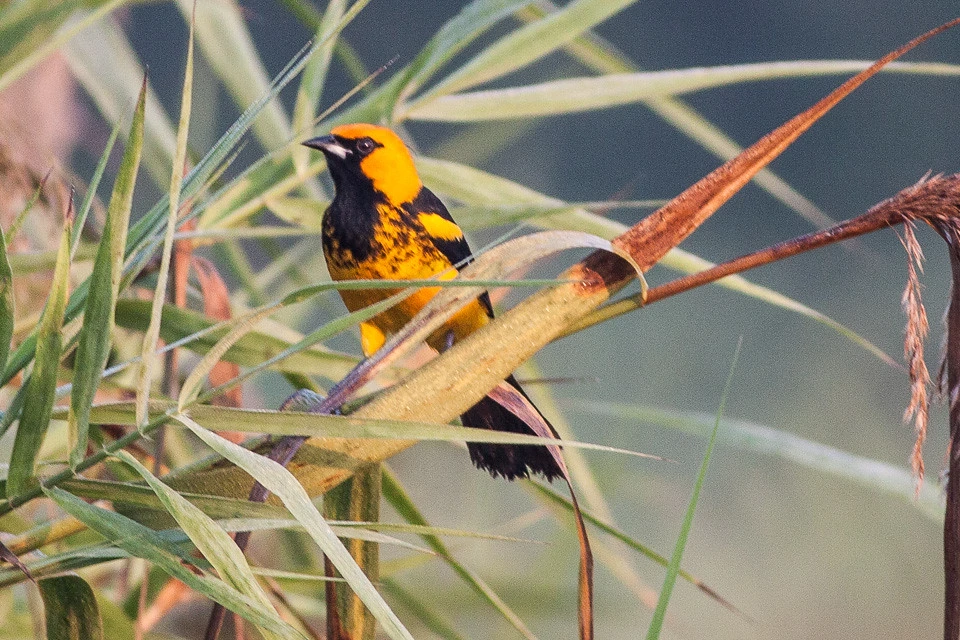 Spot-breasted Orioles in their early years exhibit a more yellowish hue with their backs, wings, and tails bearing a darker color.
Spot-breasted Orioles in their early years exhibit a more yellowish hue with their backs, wings, and tails bearing a darker color.
Adult Spot-breasted Orioles are an intriguing mix of black and orange, characterized by distinctive black spots on their breast and white edges on their wings. Their face, chest, back, wings, and tail are predominantly black.
Species: Icterus pectoralis Length: Approximately 8.3-9.4 in (21-24 cm) Weight: Roughly 1.8 oz (50 g)
Spot-breasted Orioles are relatively rare in the US, though they can occasionally be seen in Florida and along the Gulf Coast. Their primary habitats are in Mexico and the Pacific Coast of Central America.
They tend to inhabit open woodlands and dry scrublands and are often seen in more urbanized areas.
To attract Spot-breasted Orioles to your backyard, offer them fruit and sugar water.
Interesting fact: The nests of Spot-breasted Orioles are unique creations. These birds weave plant fibers into a long pouch-like structure that hangs from a tree.
29. Scarlet Tanager Female
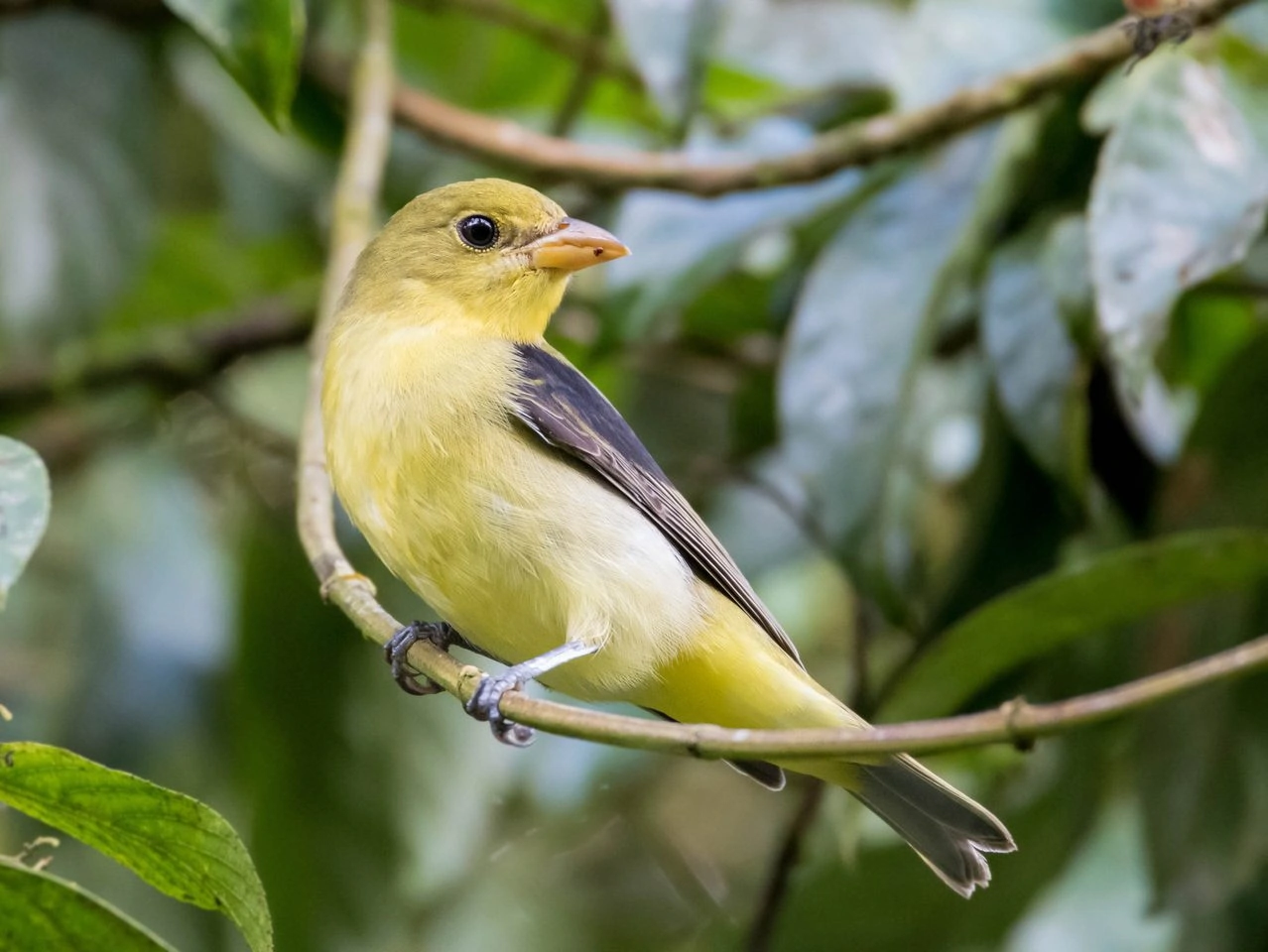
Female Scarlet Tanagers exhibit a yellow hue with wings and tails of a darker shade, a look that males also adopt after shedding their feathers.
Male Scarlet Tanagers are strikingly vibrant red birds with black wings and tails. They have robust bills and fairly short tails.
Species: Piranga olivacea Length: Roughly 6.3-6.7 inches (16-17 cm) Weight: Approximately 0.8-1.3 oz (23-38 g) Wingspan: Around 9.8-11.4 inches (25-29 cm)
During the summer, Scarlet Tanagers mate in the forests of the eastern region before migrating to the western part of South America. These birds can be spotted in southeastern states during their migratory journey.
Scarlet Tanagers can be somewhat elusive as they prefer to stay high up in the forest canopy, but you might catch a glimpse of their radiant red color as they move along branches in search of insects.
Female Scarlet Tanagers are efficient nest builders, constructing nests within a mere four days from a loose combination of twigs, grass, and plant materials. The interior is lined with soft grass, pine needles, and other comfortable materials. Typically, they lay around four eggs, which take about two weeks to hatch, and another two weeks for the fledglings to leave the nest.
To attract Scarlet Tanagers, consider planting berry plants such as blackberries, raspberries, huckleberries, juneberries, serviceberries, mulberries, strawberries, and chokeberries.
Interesting fact: Male Scarlet Tanagers engage in singing contests that occasionally escalate into physical confrontations.
30. Prothonotary Warbler
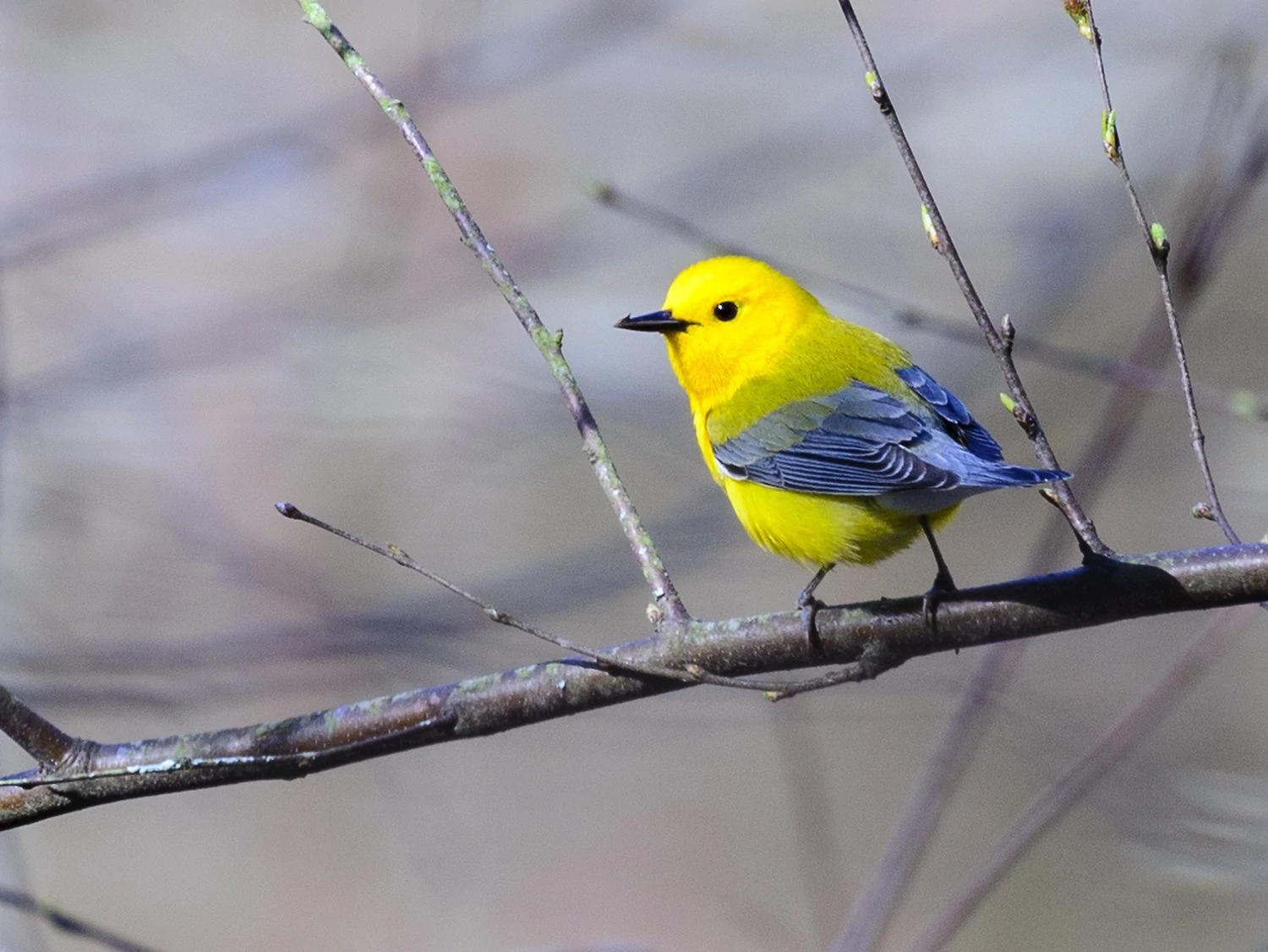
Prothonotary Warblers are strikingly vibrant with a yellow body contrasted by blue-gray wings and tails. These birds are relatively large for Warblers, and they boast thick black beaks. Their under-tails are white. The females, though similar, are slightly less vivid than their male counterparts.
Species: Protonotaria citrea Length: Approximately 5.1 inches (13 cm) Weight: Roughly 0.44 oz (12.5 g) Wingspan: About 8.75 inches (22 cm)
These warblers breed in the eastern states of the US before migrating to Mexico and further down to the northern regions of South America for the winter.
You can usually spot Prothonotary Warblers near streams and wet woodlands where they forage for spiders, insects, and snails. In the winter, their diet extends to include fruit and seeds.
Prothonotary Warblers tend to utilize abandoned woodpecker nests in trees close to water for their homes. Males initiate the nesting process by placing moss in the hole, after which the female constructs a cup-shaped nest from grass, leaves, and other plant materials.
They lay up to seven eggs, which typically take about two weeks to hatch. It then takes an additional ten days for the fledglings to leave the nest.
To entice Prothonotary Warblers into your backyard, you could consider installing a nest box, especially if your residence is close to damp areas.
Interesting fact: The term “Prothonotary” refers to the bright yellow robes worn by members of the Roman Catholic church, which is how the Prothonotary Warblers got their distinctive name.
31. Cape May Warbler
Male Cape May Warblers boast unique head features including chestnut cheeks, dark caps, and a vibrant yellow ring around the neck. Their upper bodies are streaked with yellow-olive hues while their lower bodies feature yellow with dark streaks.
The distinguishing characteristics of this warbler species are the tiger-like stripes on their chest and the unusual dark crown. Females and juvenile Cape May Warblers exhibit less brightness and lack the head coloration seen in males.
Species: Setophaga tigrina Length: Roughly 4.7-5.1 inches (12-13 cm) Weight: Approximately 0.4-0.5 oz (10.2-15.2 g) Wingspan: About 7.9-8.7 inches (20-22 cm)
These birds migrate to their breeding grounds in Canada, passing through the eastern US states. They spend their winters in the Caribbean, a narrow coastal stretch of the Yucatan Peninsula, and Central America.
In their breeding territories, Cape May Warblers are generally found in spruce forests. However, during migration, they can appear in various habitats, particularly near woodlands and scrub edges, where insects are abundant.
Their summer diet predominantly consists of spruce budworms, but they switch to fruits and nectar during winter, occasionally even visiting hummingbird feeders.
The nesting sites of Cape May Warblers are typically high up in spruce trees, close to the trunk. They construct nests from twigs, pine needles, and bark, shaping them into a cup and lining them with animal hair, feathers, and soft plant materials. They lay up to nine eggs.
To attract Cape May Warblers to your backyard, consider planting native shrubs and trees that invite insects. They may also be drawn to fruit and hummingbird feeders.
Interesting Fact: Cape May Warblers possess specially adapted tongues, curled to form a tubular shape, that enable them to lap up nectar.
32. Canada Warbler
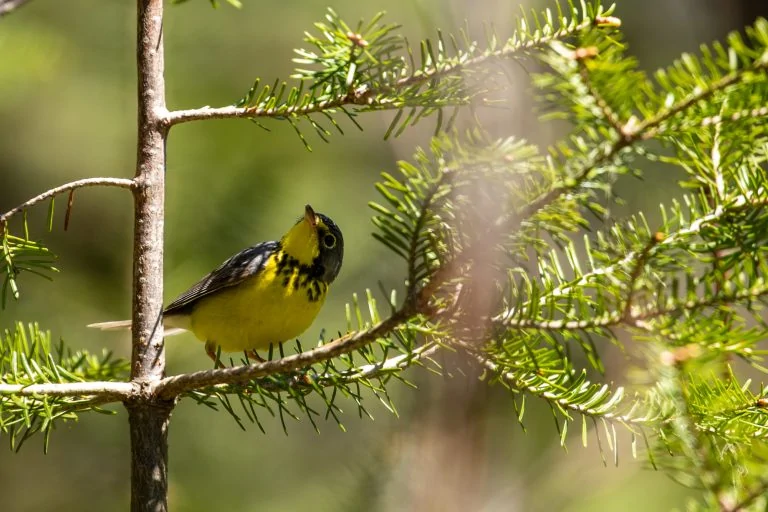
Resembling the Magnolia Warbler in many ways, Canada Warblers sport a grayish-black back and a black ‘necklace’ in males that is confined to the chest and doesn’t extend to the belly. These warblers also have yellow chests, bellies, and throats.
Females and immature Canada Warblers are similar in appearance but show a paler back and a less pronounced ‘necklace.’
Scientific Name: Cardellina canadensis Length: Approximately 4.7-5.9 inches (12-15 cm) Weight: About 0.3-0.5 ounces (9-13 g) Wingspan: Roughly 6.7-8.7 inches (17-22 cm)
Canada Warblers call Canada and the northeastern US home during breeding season, but they can be spotted across the eastern half of the US during migration. They winter in western South America.
Canada Warblers are found in conifer forests filled with rhododendrons, as well as aspen and poplar forests, where they forage for insects and spiders. Spotting them can be challenging, as their population has been dwindling.
Their nests are woven into a cup shape from grass, bark, leaves, and other plant materials and are typically situated close to the ground in shrubs or ferns. They lay up to six eggs, which take about twelve days to hatch, followed by another eight days before the young fledge.
Interesting Fact: Canada Warblers are impressive travelers, covering over 3000 miles on their journey from winter to summer territories.
33. Magnolia Warbler
Male Magnolia Warblers have a striking appearance with black backs and yellow bellies, featuring black streaks forming a “necklace” around their necks and down their bellies. On the other hand, females have a grayish back and lack the distinctive streaking on their bellies. These birds measure 4.3-5.1 inches in length, weigh 0.2-0.5 ounces, and have a wingspan of 6.3-7.9 inches. They breed in Canada and northeastern US states, migrate through the eastern US, and spend winters in Central America and the Caribbean. Magnolia Warblers can be found in forests or parks, often resting on low branches, and they feed on insects and spiders.
When it comes to nesting, Magnolia Warblers construct loose nests of grass and weeds near the trunk of conifer trees. They typically lay around four eggs that take approximately 12 days to hatch, and the young leave the nest about nine days later. To attract these birds to your backyard, it’s recommended to provide native shrubs and trees for them to rest in during migration. And a fun fact about Magnolia Warblers is that they use the white spots on their tails to attract mates and ward off competitors.
34. Nashville Warbler


Nashville Warblers have a unique appearance with a mostly yellow underside and a white lower belly. Their backs are greenish-yellow, and their heads are gray with a white eyering. However, females and juveniles are less vibrant than males. These birds measure 4.3-5.1 inches in length, weigh 0.2-0.5 ounces, and have a wingspan of 6.7-7.9 inches. They breed in northeastern US states and Canada, with a smaller population in northwestern US states and British Columbia. During migration, they can be seen in most US states and spend winters mostly in Mexico.
Nashville Warblers prefer scrubby habitats and low deciduous forests, where they hunt insects. They build their nests in shrubs close to the ground, using bark, grass, and moss to weave a cup lined with softer material. They usually lay around four eggs, which take about twelve days to hatch, and the young leave the nest after ten days. To attract these birds to your backyard during winter in southern US states, suet is recommended.
A fun fact about Nashville Warblers is that they migrate along the Atlantic Coast during their first year, but afterward, they only migrate inland.
35. Audubon’s Oriole
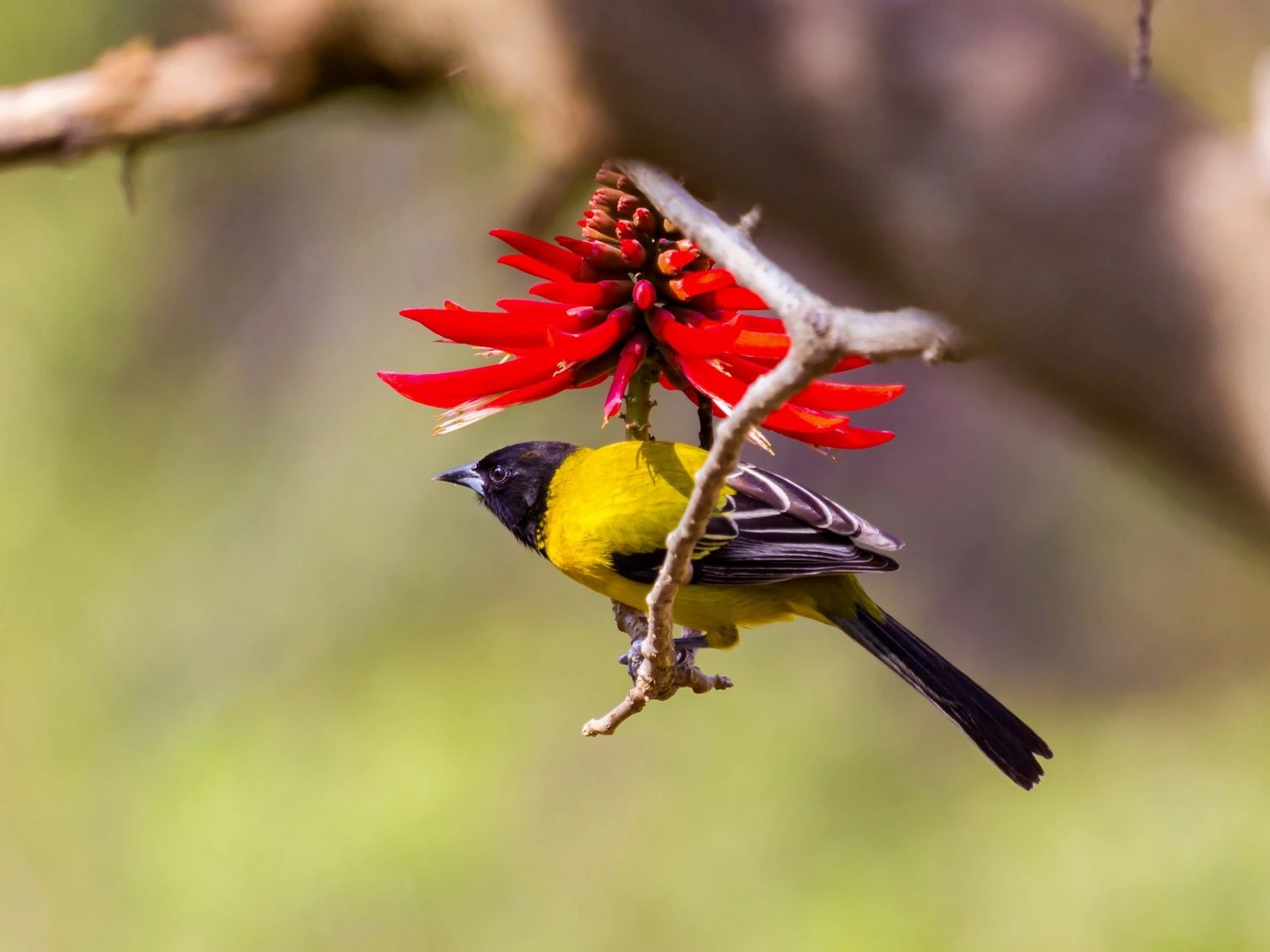
Audubon’s Orioles have a striking appearance with bright yellow and black feathers, including black wings, tails, heads, and throats. Males and females have a similar appearance. These birds measure 7.5-9.4 inches in length, weigh 1.1-1.9 ounces, and have a wingspan of 12.6 inches. Their habitat range is limited as they do not migrate, and they can be found in southeastern Texas and Mexico.
In wooded areas or thickets, Audubon’s Orioles forage for insects and fruit in thick vegetation, which makes them difficult to spot as they are shy birds. They produce a distinctive rising and falling whistle as their song, along with short high-pitched calls and harsh chattering sounds. To attract these birds to your backyard, sugar water and sunflower seeds are recommended.
A fun fact about Audubon’s Orioles is that their nests are often chosen as new homes for cowbird eggs.
36. American Redstart Female
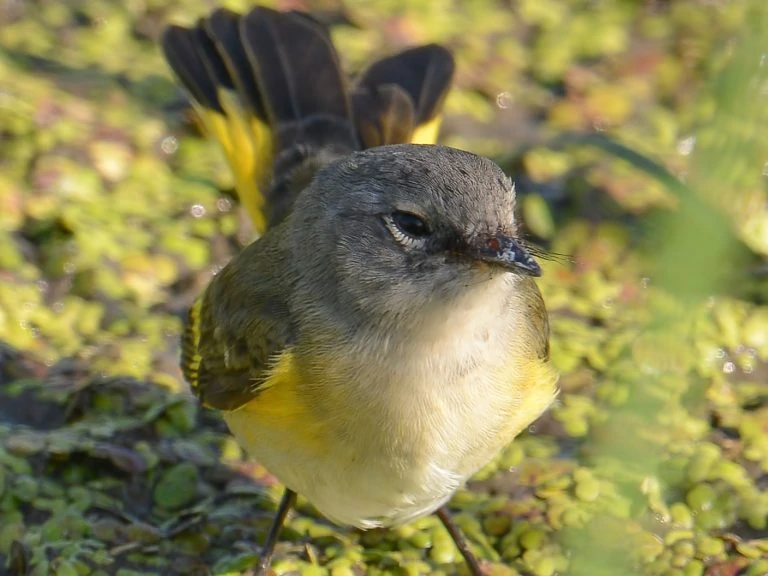
Male American Redstarts have a distinctive appearance with mostly black feathers, complemented by bright orange patches and a white belly. On the other hand, females have an olive-gray color instead of black and feature many yellow patches. These birds measure 4.3-5.1 inches in length, weigh 0.2-0.3 ounces, and have a wingspan of 6.3-7.5 inches. They breed in eastern US states and Canada, extending into northwestern US states, and can be seen during migration in central and western US states.
American Redstarts feed on insects in deciduous woodlands, backyards, and thickets, while also consuming berries such as serviceberry and magnolia.
They build their nests close to the trunk of trees or large shrubs, using bark, grass, and other plant materials. The birds usually lay up to five eggs, which take just under two weeks to hatch, and a week or two for the young to leave the nest. To attract American Redstarts to your backyard, planting berry plants such as magnolia and serviceberry is recommended.
A fun fact about American Redstarts is that their parents feed certain chicks rather than feeding them all.
37. Altamira Oriole
Altamira Orioles have a vibrant appearance with bright yellowish-orange feathers and black backs, wings, and tails. They also have black around their eyes and down their throats.
Males and females share a similar appearance, but juveniles are more yellow and have olive backs instead of black. These birds measure 8.3-9.8 inches in length, weigh 1.7-2.3 ounces, and have a wingspan of 14.2 inches. Altamira Orioles are rare in the US except for the Rio Grande Valley in Texas, where they remain year-round.
Altamira Orioles can be found in open woodlands, backyards, and wildlife refuges in southeastern Texas and along the Gulf Coast of Central America. They are often spotted at sunflower or nectar feeders. To attract these birds to your backyard, sugar water, oranges, jelly, and sunflower seeds are recommended.
A unique aspect of Altamira Orioles is that they stay in breeding pairs year-round and build hanging nests measuring up to 2 feet long.
38. Yellow-throated Vireo
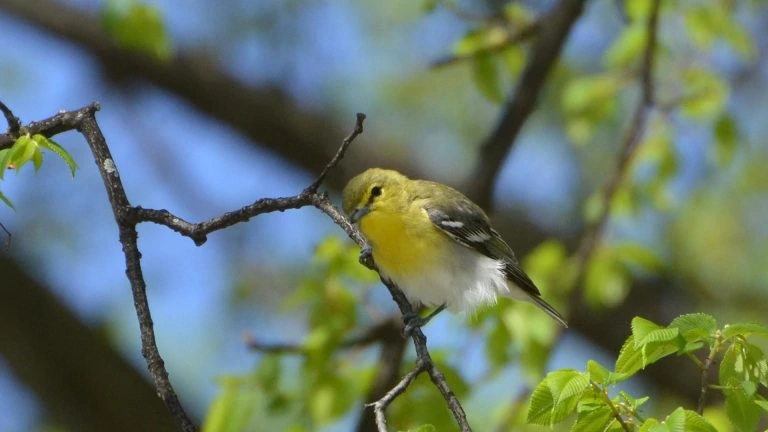
Yellow-throated Vireos are birds with bright yellow and gray feathers, olive-colored heads, and bright yellow throats and chests. They have white bellies and grayish-brown backs with white streaks. These birds measure 5.1-5.9 inches in length, weigh 0.5-0.7 ounces, and have a wingspan of 9.1 inches. They breed in eastern US states and spend winters in Central and South America and the Caribbean.
Yellow-throated Vireos can be found in mixed woodlands, where they hunt for insects and sometimes berries. Their nests are hanging cups built high up in trees and attached to a fork in the tree. They use bark, grass, pine needles, and other plant material to create the cup, held together with spider webs and insect silk. They usually lay around four eggs, which take about two weeks to hatch, and two more weeks for the young to leave the nest.
A fascinating fact about Yellow-throated Vireos is that males create little piles of twigs in several locations and pretend to build nests when females arrive, hoping to attract them.
39. Eastern Yellow Wagtail
Eastern Yellow Wagtails have a bright yellow underside and yellowish-green back, with tails that bob up and down. These birds measure 6.5 inches in length, with a weight of 0.62 ounces. They are mostly found in Asia, but they also breed in western Alaska.
Eastern Yellow Wagtails can be found in scrubby tundra and marshes, where they hunt for insects on the ground near water. Their nests are hidden under vegetation on the ground, constructed with grass, weeds, and moss. They usually lay around five eggs that take around twelve days to hatch, and an additional twelve days for the young to leave the nest.
40. Couch’s kingbird
Eastern Yellow Wagtails are striking birds with a bright yellow underside and yellowish-green back, and they are known for their bobbing tails. These birds measure around 6.5 inches in length and weigh 0.62 ounces. Although they are typically found in Asia, they also breed in western Alaska.
Eastern Yellow Wagtails can be observed in scrubby tundra and marshes near water, where they search for insects on the ground. Their nests are built from grass, weeds, and moss, and are hidden under vegetation on the ground. They usually lay around five eggs, which take about twelve days to hatch, followed by twelve more days for the young to leave the nest.
41. Tropical kingbird
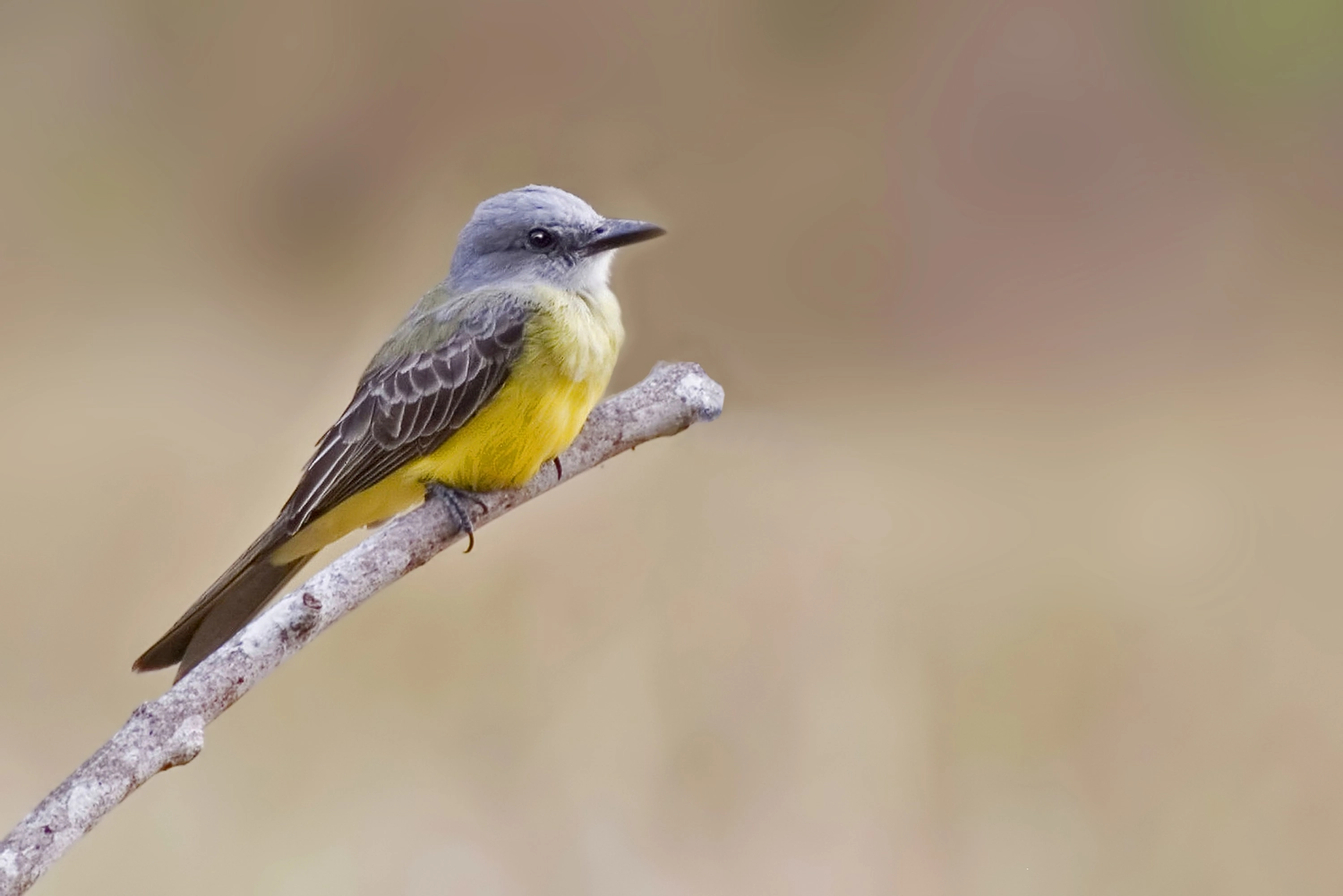
Tropical Kingbirds, renowned for their imposing size among flycatchers, display a radiant yellow belly contrasting with a gray back, accompanied by gray-brown wings and tail.
Scientific Name: Tyrannus melancholicus Dimensions: Length ranges from 18-23 cm (7.1-9.1 in) Mass: Typically weighs between 32-43 g (1.1-1.5 oz)
These birds habitually reside in Central and South America. However, they venture north into the southern regions of the United States for breeding purposes, and occasionally grace the Pacific Coast of the US.
Tropical Kingbirds favor open landscapes teeming with flying insects, constituting their primary diet. They also supplement their meals with fruit and berries.
Tropical Kingbird females construct their nests high in the trees. These nests are an untidy assortment of twigs, vines, and grass, and usually house around three eggs.
Interesting Tidbit: Tropical Kingbirds demonstrate strategic nesting preferences, often setting up near wasps or blackbirds. These neighbors are notorious for their aggressive defense against nest predators, providing an added layer of protection for the Kingbirds.
42. Yellow-bellied Flycatcher
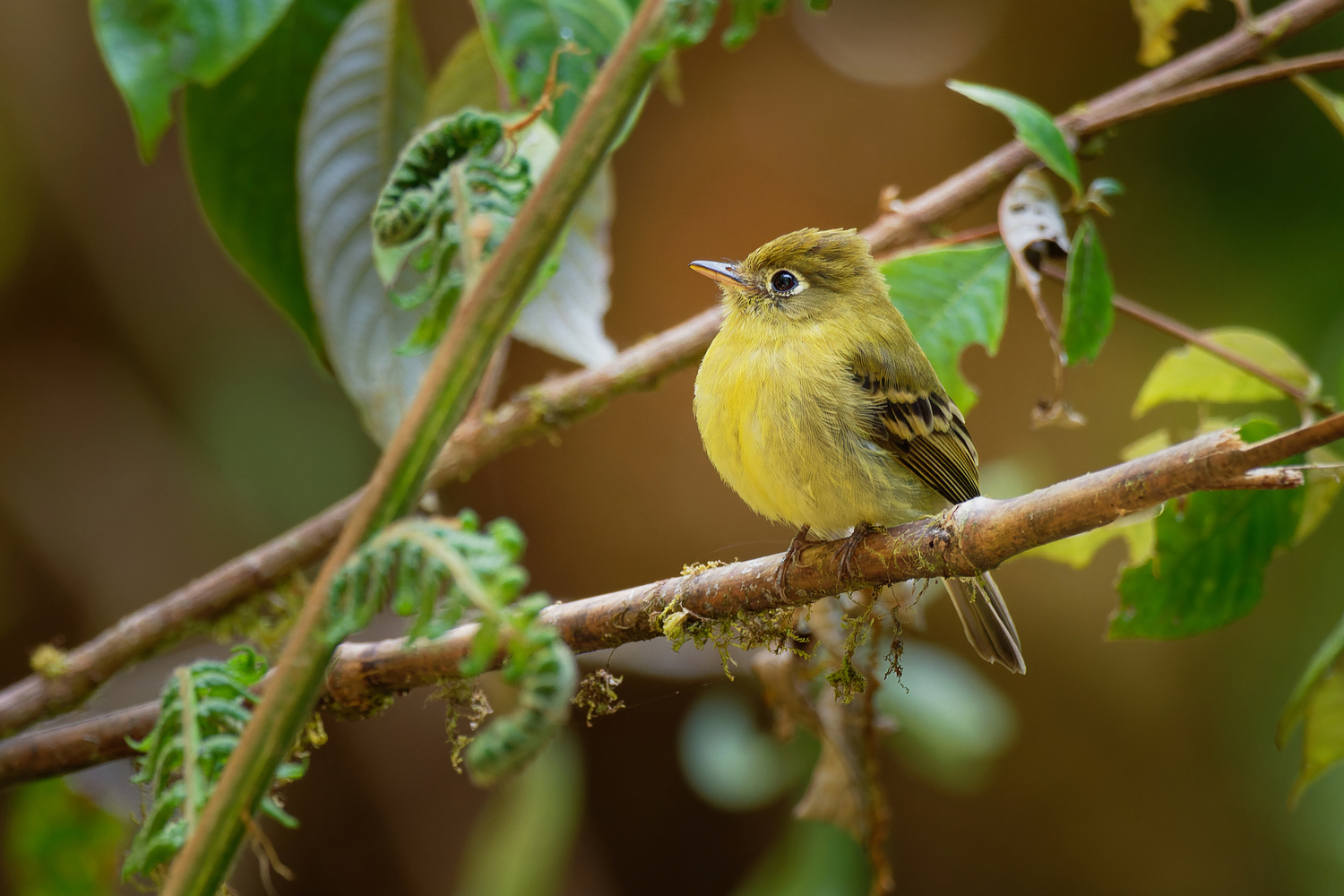

Yellow-bellied Flycatchers are petite flycatchers characterized by their yellow undersides and greenish-yellow backs. They sport two faint wingbars and a distinctive white ring around their eyes.
Scientific Name: Empidonax flaviventris Size: Length varies from 13-15 cm (5.1-5.9 in) Weight: Typically around 9-16 g (0.3-0.6 oz) Wingspan: Ranges from 18-20 cm (7.1-7.9 in)
These flycatchers breed in the expanses of Canada and the northeastern United States. Come winter, they migrate to warmer climates in Mexico and Central America. During their migratory journey, they can be spotted across the eastern US states.
Yellow-bellied Flycatchers inhabit coniferous forests and moist environments like swamps and bogs. These agile birds catch their insect prey mid-flight or pluck them off leaves and vegetation. On occasion, they also consume berries, even those from poison ivy, and other fruits.
Nests of these flycatchers are cleverly concealed on the ground, typically beneath a log, root, or cluster of ferns, and are woven from moss and grass. The female lays up to five eggs, which take approximately two weeks to hatch. The fledglings then take an additional fortnight to be ready to leave the nest.
43. Blue-winged Warbler
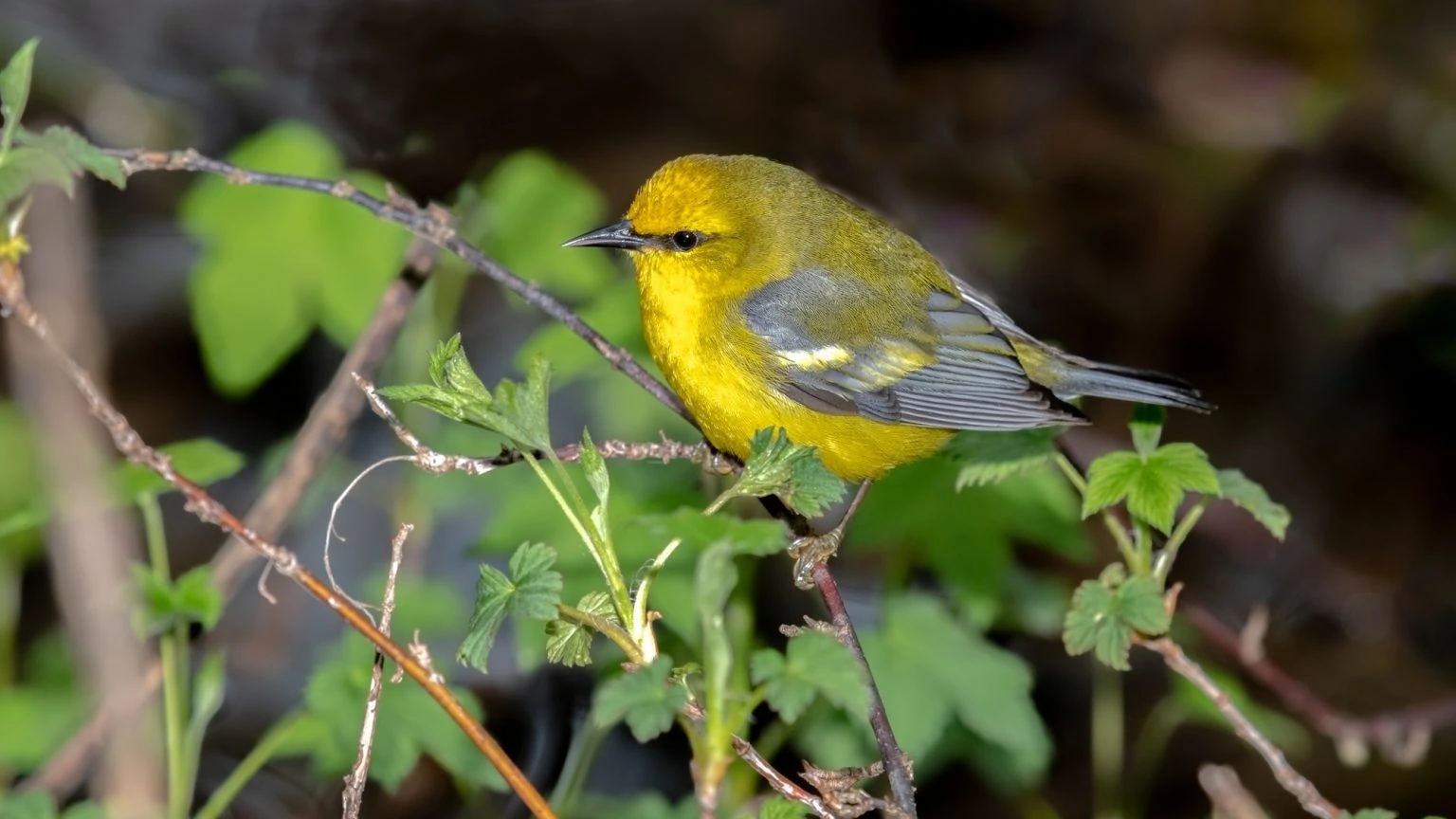
Blue-winged Warblers get their moniker from their unique bluish-gray wings. Adult specimens boast a yellow-green hue on their upper bodies, along with a black eye stripe extending from their elongated beaks across their eyes, giving them a somewhat stern appearance.
Their chest and belly are predominantly vibrant yellow. While females may exhibit a slightly lighter shade, they are usually indistinguishable from males. Both adults and juveniles possess two white wing bars, although in juveniles, these bars are so faint they’re nearly invisible.
Scientific Name: Vermivora cyanoptera Dimensions: Length is about 4.75 inches (12 cm) Weight: Approximately 0.3 oz (9 g) Wingspan: Ranges from 6.75 to 7.5 inches (17 – 19 cm)
Blue-winged Warblers breed primarily in the eastern US, barring southern states. However, they can be spotted in these areas during their migration to Mexico, Central America, and the Caribbean for the winter months.
These warblers are typically found in old, overgrown fields and pastures, forest fringes, and dense shrubbery. They tend to prefer high-altitude areas replete with grass and canopy coverage.
Blue-winged Warblers subsist on a diet of insects and spiders located in various plants and trees. They often dangle upside down from tree branches to scan under leaves for insect larvae to feed their offspring.
Their nests, often cup-shaped and constructed from dead leaves, are typically found either on the ground, amidst thick bushes, or within dense undergrowth. The female lays between four to seven eggs, which she incubates for roughly 12 days.
Interesting Tidbit: Blue-winged Warblers frequently crossbreed with Golden-winged Warblers, resulting in the creation of Brewster’s and Lawrence’s Warblers.
44. Dickcissel
The male Dickcissel is a prominent, hefty bird, recognized by its signature black patch on the throat and vibrant yellow breast. Its yellow eyebrow stripe stands out against its grayish head. The female exhibits similar markings, albeit in a more subdued or lighter shade. However, she lacks the black throat patch and displays only a subtle hint of yellow on the chest.
Scientific Name: Spiza americana Dimensions: The length is about 14-16 cm (5.5-6.3 in) Weight: Generally weighs between 25.6-38.4 g (0.9-1.4 oz) Wingspan: Spans between 24.8-26 cm (9.8-10.2 in)
Dickcissels breed in the Central and Great Plains of the US and then embark on a migration journey to Mexico, Central America, and the northern part of South America.
Dickcissels are usually spotted in meadows and prairies, lofty grasslands, lightly grazed pastures, and alongside roads.
These birds have a diet that consists mainly of insects and seeds. During the summer, they feast on grasshoppers, caterpillars, beetles, and crickets. In other seasons, their diet shifts towards seeds, weeds, grasses, and farmed grain.
Dickcissel nests can be found nestled in small, dense shrubs, grasses, and trees, up to a height of four feet. These substantial nests are crafted from weeds, grass, and leaves, and lined with fine grass and animal fur for a soft touch. The female can lay up to six eggs, which hatch in about two weeks. The young ones become flight-ready after approximately ten days.
Interesting Tidbit: When the autumn migration season arrives, Dickcissels gather in large groups that can swell from thousands to millions by the time they reach their winter territories.
45. Painted Bunting – Female
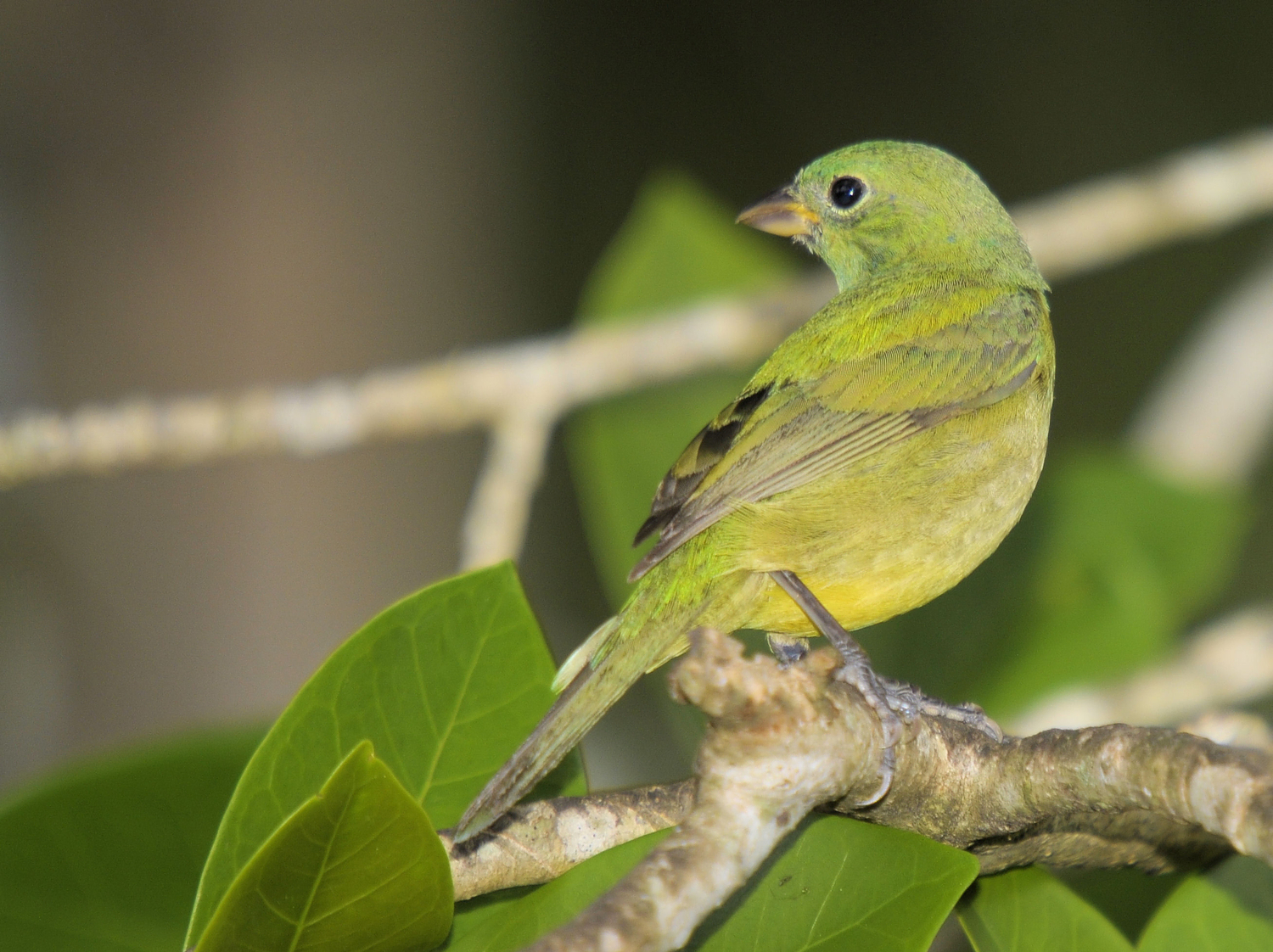
Male Painted Buntings are strikingly vibrant birds, characterized by their vivid blue heads, green wings, and backs, complemented by predominantly red undersides. In contrast, the females display a brilliant yellow-green hue.
Scientific Name: Passerina ciris Size: Length ranges from 12-13 cm (4.7-5.1 in) Weight: Approximately 13-19 g (0.5-0.7 oz)
Painted Buntings breed in select US states, primarily in south-central regions and specific coastal areas in the southeast. They undertake nocturnal migrations to Central America, southern Florida, and a handful of Caribbean islands.
These birds inhabit semi-open environments where they primarily forage for seeds and insects during the breeding season.
The nests of Painted Buntings are carefully concealed in vegetation around five feet off the ground. Females construct these nests using twigs, bark, grass, and plant material, utilizing cobwebs to bind everything together and lining the nests with horsehair. Typically, they lay around four eggs that take roughly ten days to hatch, with the fledglings taking another nine days to emerge.
To attract Painted Buntings to your backyard, provide plenty of their preferred seeds, such as white millet or black oil sunflower seeds, and ensure there is dense vegetation for them to take cover.
Interesting Tidbit: Despite their colorful, non-threatening appearance, male Painted Buntings can be remarkably aggressive, engaging in fights that can occasionally be fatal.
